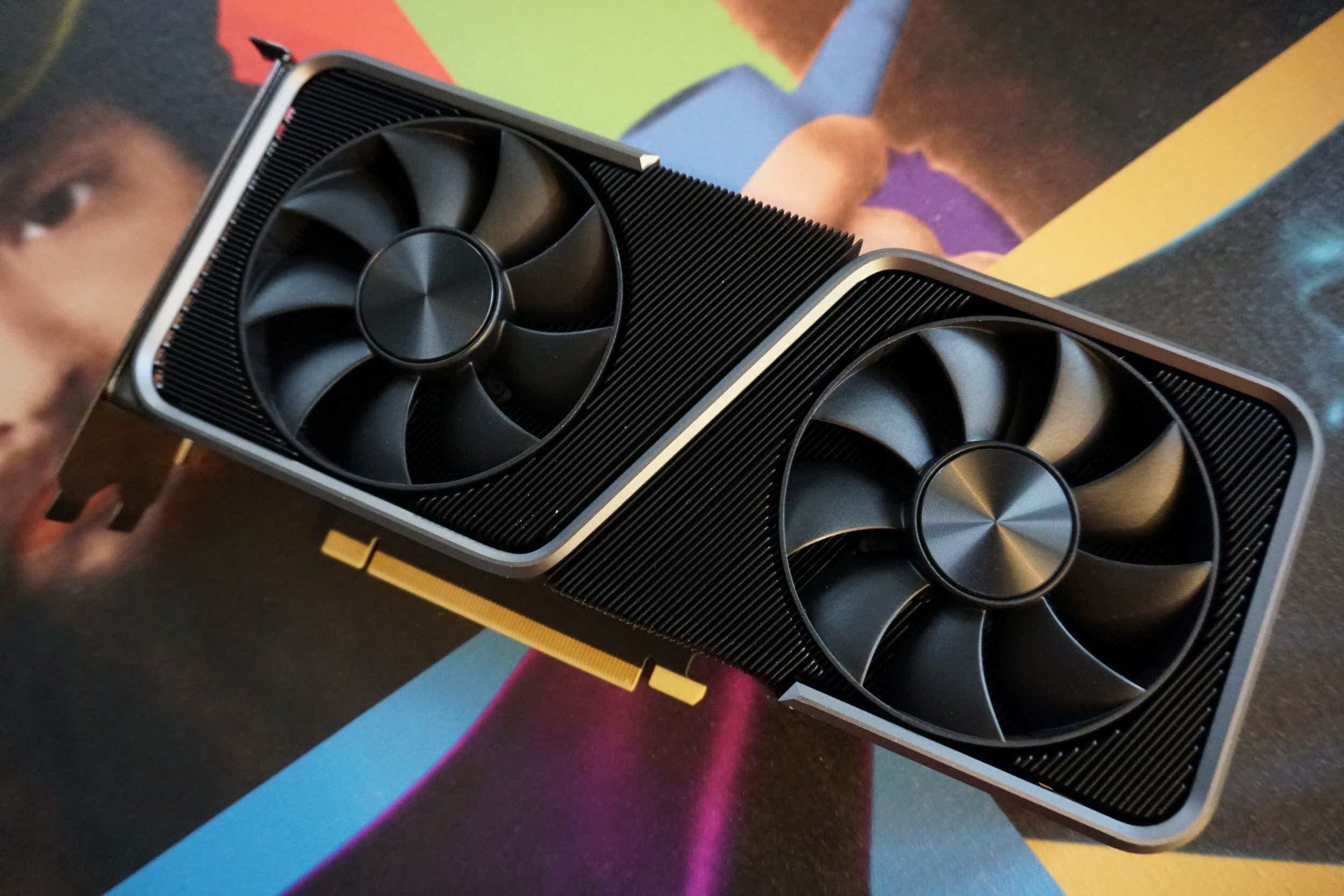 At a Glance
At a GlanceExpert's Rating
Pros
- Excellent 4K and 1440p gaming
- Much better 1080p performance than GeForce
- 16GB memory capacity
- Ray tracing at 1440p and 1080p
- Vastly improved cooler
- Gets faster when paired with Ryzen 5000
- Standard length and power pins
Cons
- Ray tracing is faster on GeForce GPUs
- No answer to Nvidia’s DLSS
Our Verdict
AMD’s Radeon RX 6800 outperforms the RTX 3070 and offers twice as much memory, easily justifying its higher price. It can get even faster paired with a Ryzen 5000 processor, but Nvidia’s rival GeForce GPUs hold a ray tracing advantage.
Best Prices Today: Radeon RX 6800
With the debut of the Radeon RX 6800 and RX 6800 XT, AMD is clearly on a roll.
Mere weeks ago, the company’s Ryzen 5000 processors seized the unquestionable performance lead from Intel—yes, even in games—for the first time in over a decade. On Wednesday, it’s the graphics division’s turn to shine with these two Radeon RX 6000-series “Big Navi” graphics cards powered by AMD’s new RDNA 2 architecture.
Rival Nvidia has largely been competing against itself in the high-end GPU space for several years now. AMD’s Vega offerings showed up disappointingly late and disappointingly underpowered in 2017, followed by (awesome) first-gen RDNA cards that sadly topped out with the midrange Radeon RX 5700 XT in 2019. The Radeon RX 6000-series ends Nvidia’s streak.
AMD’s $579 Radeon RX 6800 dominates Nvidia’s GeForce RTX 3070 across the board in traditional games. The $649 Radeon RX 6800 XT trades blows with the GeForce RTX 3080 at 4K resolution and often wins outright at lower resolutions, for $50 less than Nvidia’s flagship. Both cards come equipped with vastly upgraded coolers and beefy 16GB memory setups that leave Nvidia’s VRAM looking downright stingy in comparison. They are further bolstered by an innovative new “Infinity Cache” technology that cribs ideas from AMD’s server processors. And yes, RDNA 2 adds real-time ray tracing to Radeon’s arsenal—though, crucially, no DLSS rival.
Welcome back to the high end, AMD. The Radeon RX 6800-series comes ready to play tomorrow’s games just as well as today’s. Let’s dig in. There’s a lot to cover, so if you want to jump to a specific section, use one of the handy links below:
- Radeon RX 6800-Series: Specs, features, and RDNA 2
- Radeon RX 6800 and 6800 XT physical design
- Better with Ryzen: AMD Smart Access Memory
- Our test system
- Radeon RX 6800 and 6800 XT gaming benchmarks
- Radeon RX 6800 and 6800 XT ray tracing performance
- Power draw, thermals, and noise
- Should you buy the Radeon RX 6800 or 6800 XT?
[ Further reading: Best graphics cards for PC gaming ]
Radeon RX 6800-series: Specs, features, and RDNA 2
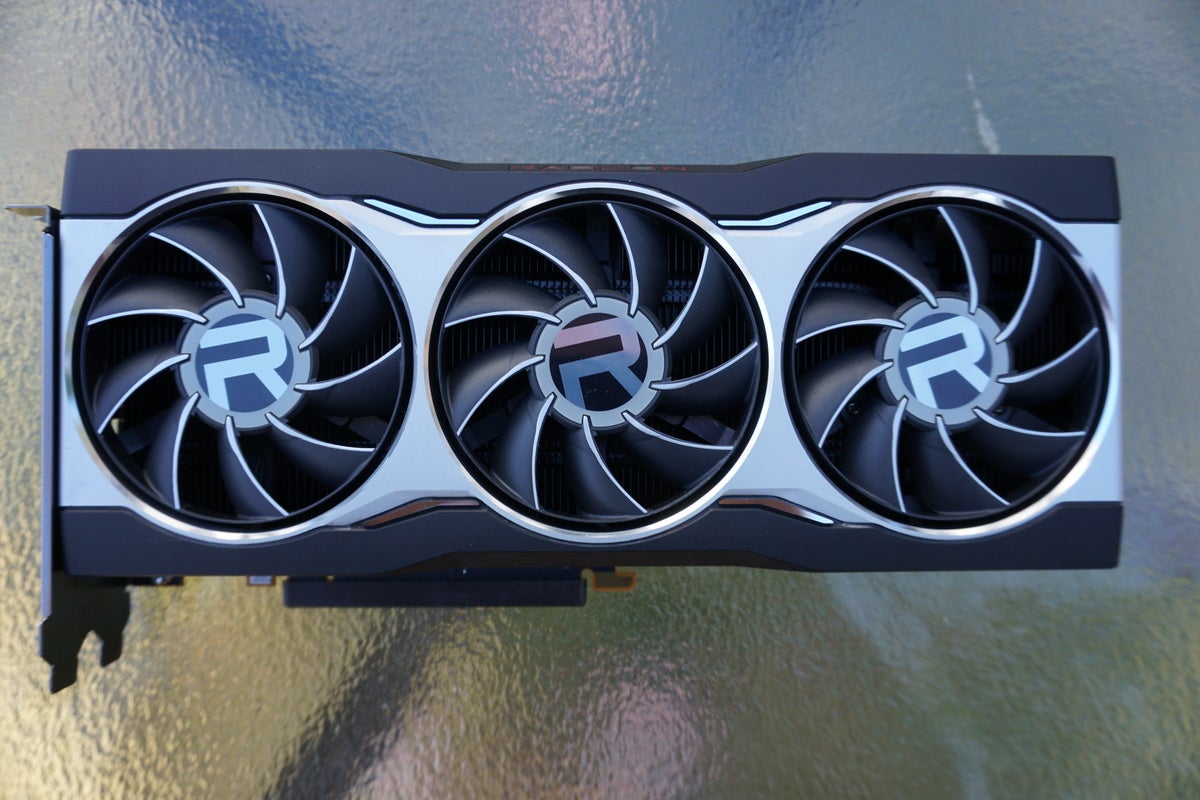 Brad Chacos/IDG
Brad Chacos/IDGGraphics processors built using AMD’s upgraded RDNA 2 architecture beat in the heart of the Radeon RX 6800 and 6800 XT, packed with more, well, everything than their predecessors. The new 7nm GPUs include more compute units, more stream processors, more memory, more ROPs, higher speeds, you name it:
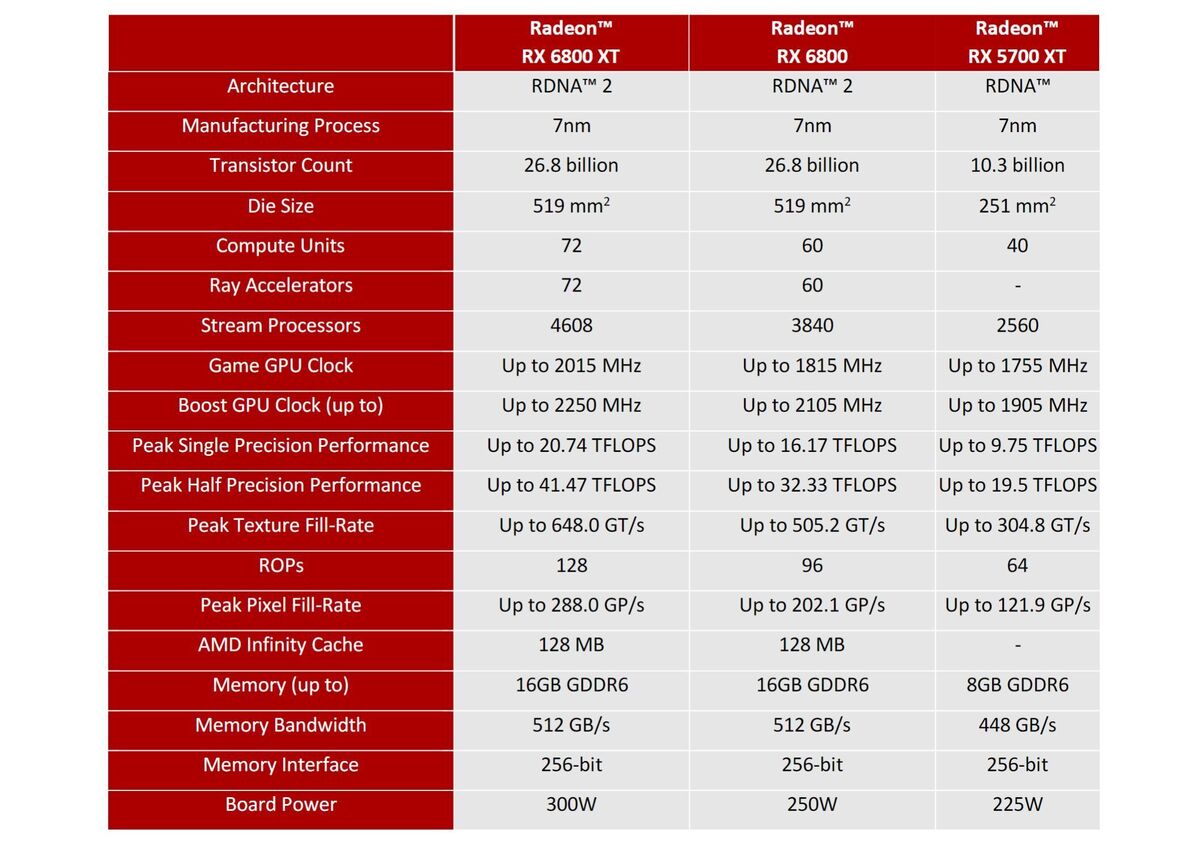 AMD
AMDRDNA 2’s ultimate 80-compute-unit incarnation will hit the streets as the $999 Radeon RX 6900 XT, which will challenge Nvidia’s $1,500 GeForce RTX 3090 when it launches December 8. We devoted an entire article to what’s new inside the RDNA 2 architecture if you’re interested in learning more, but we’ll hit the highlights here.
The Radeon RX 6000-series hits much higher clock frequencies than its predecessors (and rivals), with the both the Radeon RX 6800 and 6800 XT exceeding the 2GHz barrier at peak speeds. They stay swift even under load. The Radeon RX 6800 XT is rated for a 2,015MHz Game Clock—AMD’s term for the expected frequency during gameplay—and boosts all the way up to a ludicrous 2,250MHz in some scenarios. Activating the new, optional “Rage Mode” in Radeon Software on the Radeon RX 6800 XT can send the card soaring even higher by increasing the power limit and fan speeds. Alternatively you can turn on Quiet mode for much cooler, quieter operation and a mere one-percent hit to performance, AMD says. (Rage mode isn’t available on the non-XT 6800.)
 AMD
AMDFirst-gen RDNA graphics cards couldn’t hit these speeds for many reasons, but the memory subsystem was part of it. The Radeon RX 5000-series simply couldn’t scale up as far as these new Radeon RX 6000-series GPUs can without becoming starved for memory bandwidth, AMD engineers said. This generation of cards includes a revolutionary “Infinity Cache” to help with the problem.
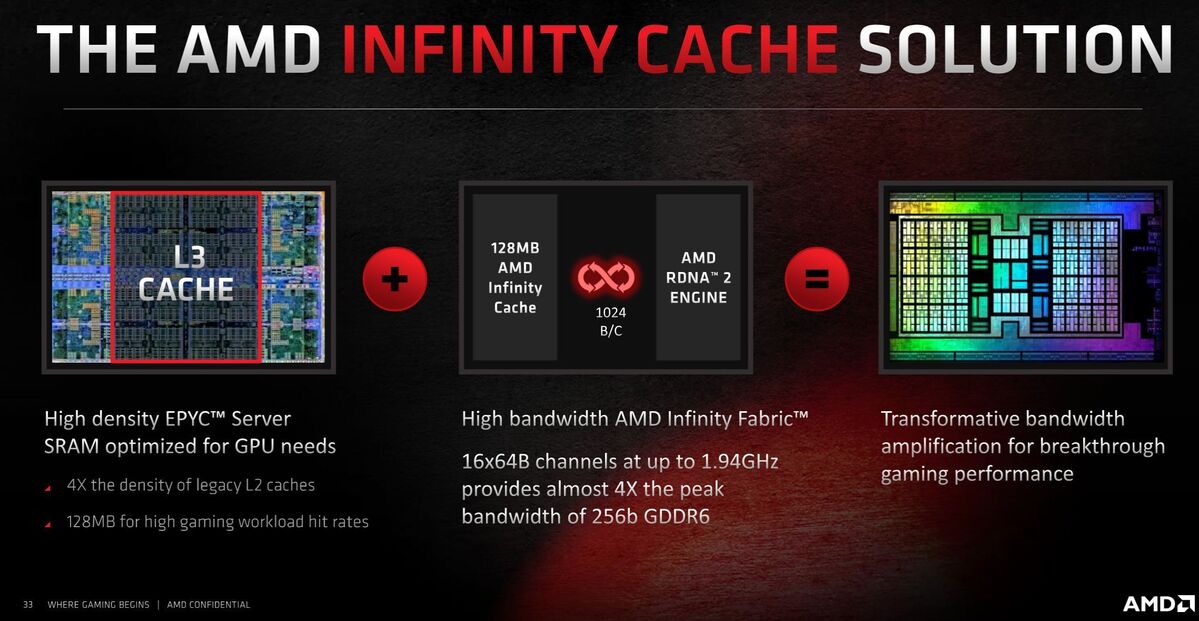 AMD
AMDThe Radeon RX 6800, 6800 XT, and forthcoming 6900 XT all include a massive 128MB Infinity Cache baked right into their GPUs. It’s essentially a big chunk of L3 SRAM inspired by a similar configuration in AMD’s Epyc processors, but four times denser and optimized for gaming workloads. (Ryzen processors also recently adopted a massive L3 cache to improve gaming performance.)
 AMD
AMD
The RDNA 2 die.
Equipping the GPU with such a large, high-speed cache lets it keep most of the working data for any given frame on-die, which keeps the GPU from having to send signals all the way across the package to the 16GB of onboard GDDR6 memory in many cases, especially since the Infinity Cache holds a lot of temporal and spatial data that can be reused in subsequent frames. That improves both power efficiency and latency, and allowed AMD to pair the hefty 16GB of GDDR6 memory in the Radeon RX 6800-series with a modest 256-bit bus with no ill effects in games.
By comparison, Nvidia’s RTX 3080 and 3090 deploy faster, but more power-hungry GDDR6X memory across much wider bus widths for a higher raw memory bandwidth. The GeForce RTX 3070 also uses GDDR6 and a 256-bit bus like the Radeon RX 6000-series, but its memory modules aren’t as fast as the ones in AMD’s cards, so it offers less raw bandwidth.
AMD easily wins the capacity war, however, and that’s perhaps an even more important metric. Today’s games can use a lot of memory when you have all the graphical bells and whistles turned on at 4K resolution, and ray tracing demands even more. The Radeon RX 6800 and 6800 XT both come with a welcome 16GB of GDDR6, while Nvidia put 10GB of GDDR6X on the RTX 3080 and just 8GB of GDDR6 on the RTX 3070—a total already being exceeded by games like Watch Dogs: Legion and Doom Eternal.
The Infinity Cache helps with ray tracing, too. The cutting-edge lighting technology debuted in Nvidia’s RTX 20-series GPUs and comes to AMD hardware for the first time in the Radeon RX 6000-series. RDNA 2 includes a new ray accelerator in each compute unit dedicated to handling ray tracing. AMD targeted playable 1440p performance with ray tracing active for its debut, and it succeeds by and large, as you’ll see when we dive into ray tracing performance later.
Ray tracing basically works by having dedicated hardware perform calculations of how the light rays behave, using a technique known as bounding volume hierarchy (BVH) traversal. Performing that task is very memory-intensive, which is why VRAM demands leap up when you enable ray tracing in a game. AMD says it’s able to keep “a very high percentage of the BVH working set” directly inside the Infinity Cache, reducing latency and improving overall performance.
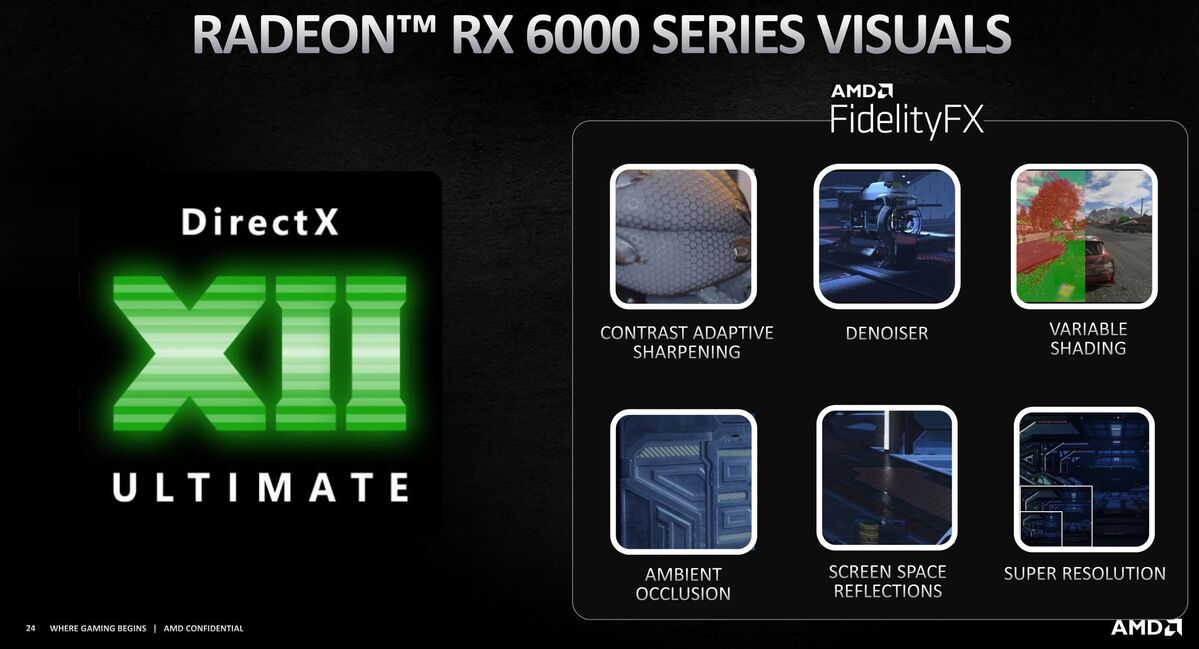 AMD
AMD
See the “Super Resolution” in the corner?
What AMD lacks—for now—is a DLSS alternative. Nvidia’s Deep Learning Super Sampling technology leans on dedicated tensor cores inside GeForce GPUs to render games at lower resolutions internally, then upscale the final output image using machine learning algorithms to fill in the blanks. Doing so lets GeForce graphics cards claw back some of the frames lost to ray tracing’s substantial performance impact. DLSS 2.0’s black magic is very much proprietary to Nvidia, however. AMD has teased a new “FidelityFX Super Resolution” feature that could be a more open DLSS alternative. The company claims it could have wider adoption because RDNA 2 also powers the new Xbox Series X and PlayStation 5 consoles. For now, however, DLSS is a killer feature that Radeon can’t match.
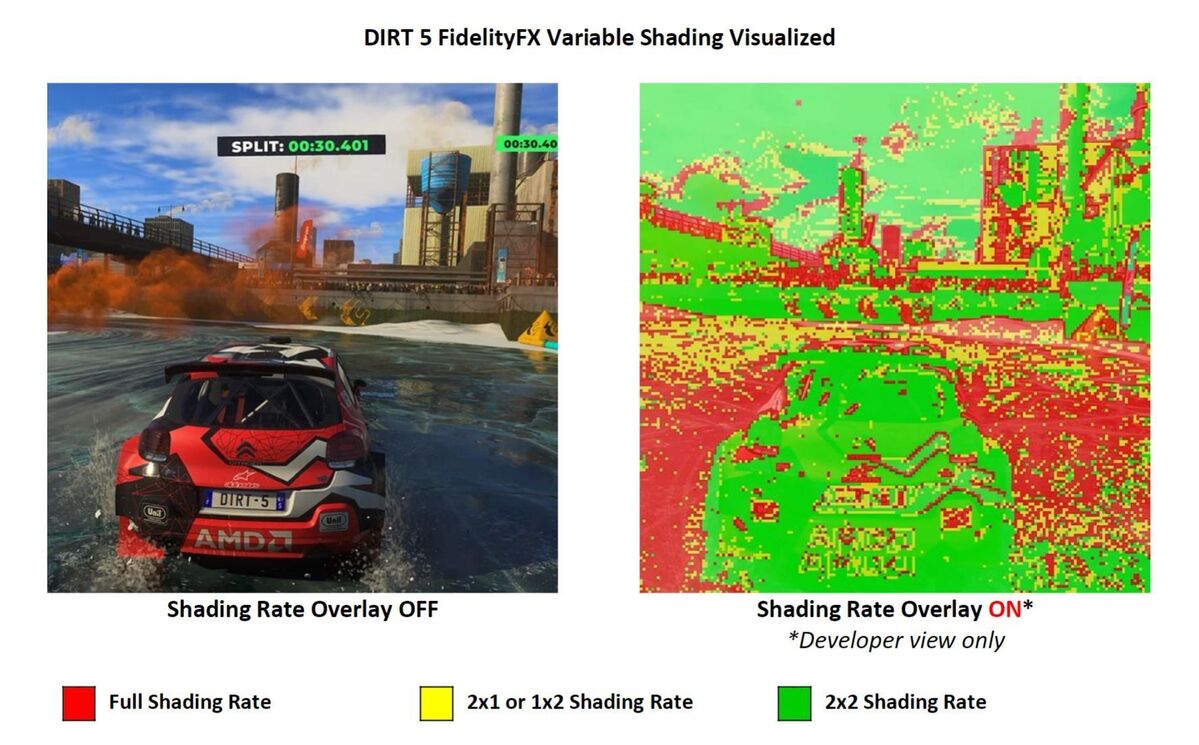 AMD
AMD
Variable-rate shading renders key portions of the screen at full fidelity, but blends less-visible areas together to boost performance with little to no image quality loss.
Ray tracing is just one of the DirectX 12 Ultimate features enabled on the Radeon RX 6000-series (and Nvidia’s rival RTX graphics cards). AMD’s new GPUs can also handle nifty tricks like mesh shading, variable rate shading, and sampler feedback, which we covered in our look at DirectX 12 Ultimate. Because the Xbox Series X also supports DX12 Ultimate, hopefully we’ll start to see more games include the performance-boosting features going forward. The Radeon RX 6800 and 6800 XT will also support Microsoft’s DirectStorage API, which debuted on the Xbox Series X and aims to kill game-loading times on the PC.
Phew! Believe it or not, that was indeed a brief look at AMD’s technical highlights. Check out our RDNA 2 deep-dive explainer for much more info about the Radeon RX 6000-series’ ray tracing, Infinity Cache, clock speeds, and more.
Next page: Physical design
Radeon RX 6800 and 6800 XT physical design
The Radeon RX 6000-series also marks a new era for the outside of AMD graphics cards.
 Brad Chacos/IDG
Brad Chacos/IDGFor years, both AMD and Nvidia offered reference designs of their cards that used blower-style cooling. As detailed in our reference vs. custom card explainer, blower cards are good for small or cooling-constrained systems, because they blow the hot air fully out of your system rather than routing it through your case. The downside? Blower-style coolers tend to run hotter and louder than graphics cards with axial fans, and AMD’s past reference designs were notorious examples of those traits. (I hate just being in the room with a reference Vega 64 or 290X.)
Nvidia switched to axial cooling for its Founders Edition reference models with the RTX 20-series and immediately achieved much better cooling. This disparity made AMD’s blower-style cooling on the last-gen Radeon RX 5700 and 5700 XT stick out even more. With the Radeon RX 6000-series, AMD is ditching blower-style coolers, too.
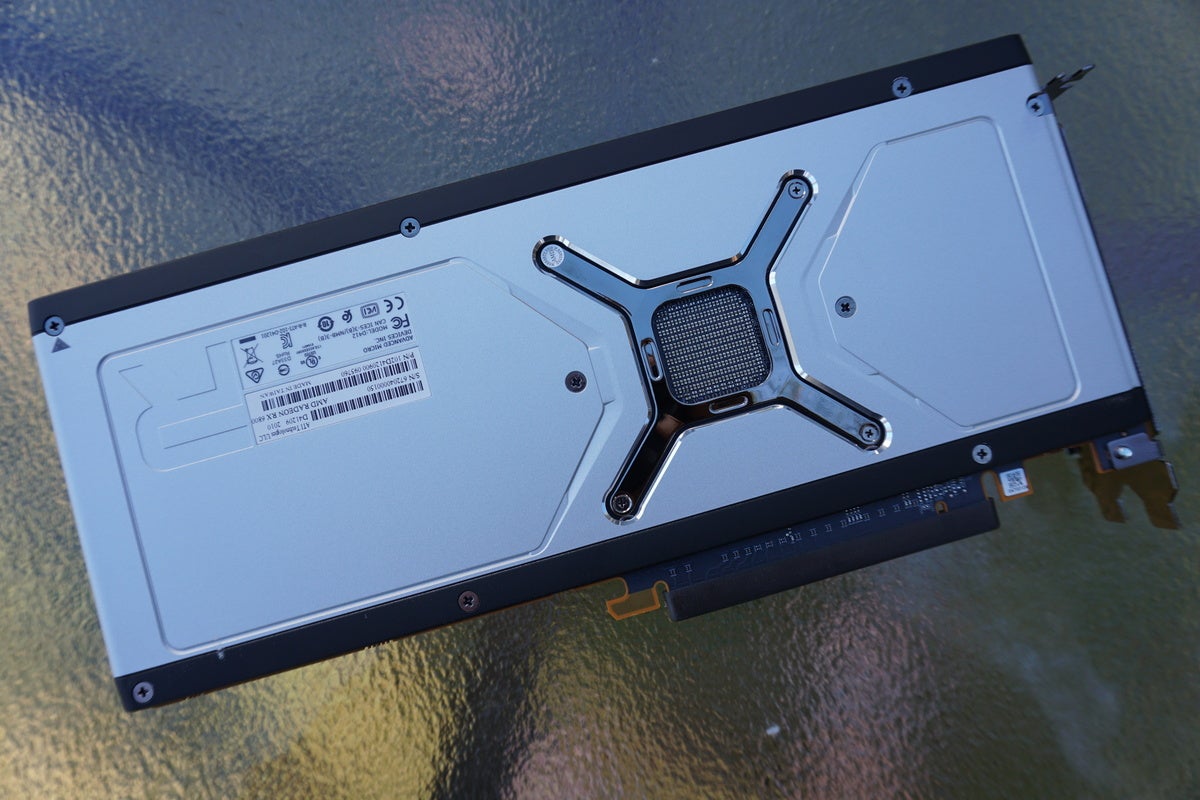 Brad Chacos/IDG
Brad Chacos/IDGAMD outfitted its new graphics cards with a premium, all-metal cooler with a trio of axial fans, complete with a sleek silver backplate and an illuminated Radeon logo. We covered the new design in depth in our unboxing of the Radeon RX 6800 and 6800 XT.
They look like standard (yet swanky) high-end graphics cards, frankly, and AMD claims that was a goal. While Nvidia’s GeForce RTX 30-series Founders Edition cards pack radical (and effective) “flow-through” push-pull coolers and a proprietary 12-pin connector, the Radeon cards stick to established norms, from their 10.5-inch length to their dual 8-pin power connectors.
Do note that the Radeon RX 6800 XT measures 2.5 slots thick, however. That’s not unusual for an enthusiast-class graphics card—virtually all custom RTX 3080s and last-gen 2080 Ti cards were three slots as well—but it means the GPU might not fit in particularly snug cases.
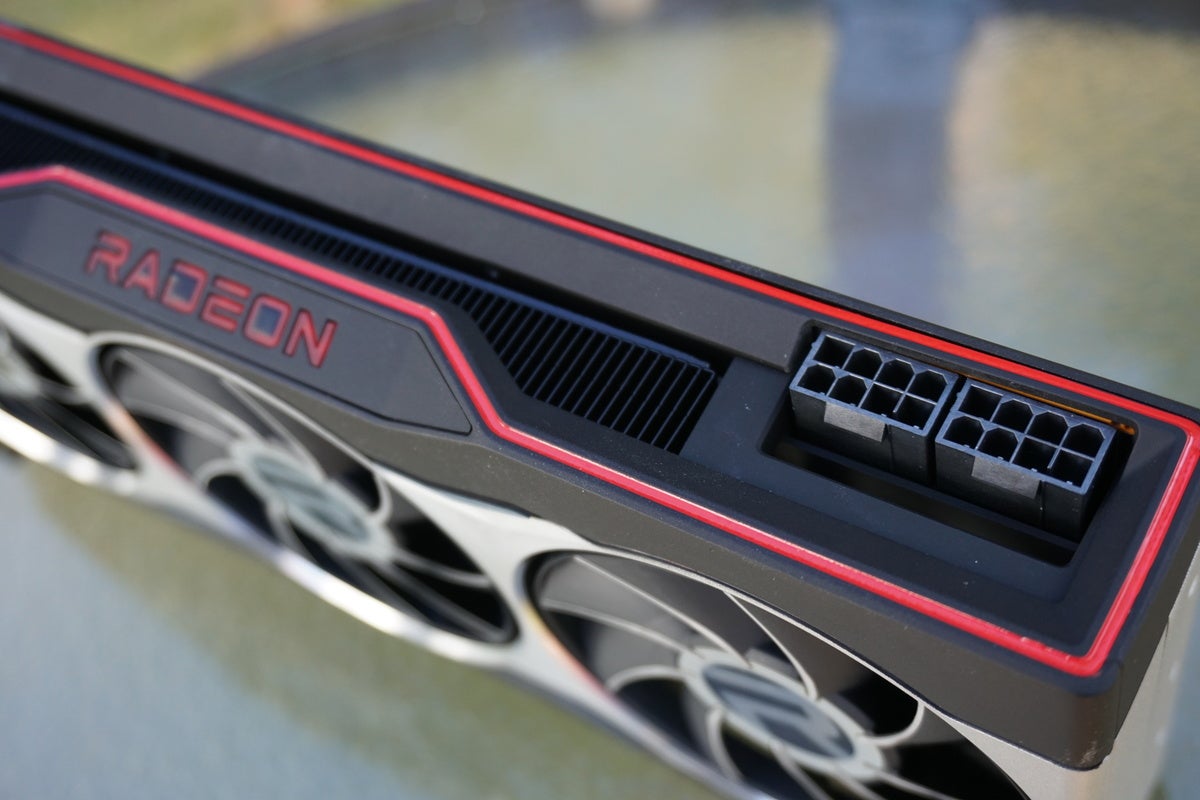 Brad Chacos/IDG
Brad Chacos/IDG
Standard 8-pin connectors.
As you’ll see in our benchmarks later, this new design is a massive step up over the blower coolers of yesteryear. It’s significantly quieter and keeps the GPU much chillier. That’s especially good news becausee today’s launch will be limited to this reference design alone. Custom boards are scheduled to hit the streets November 25.
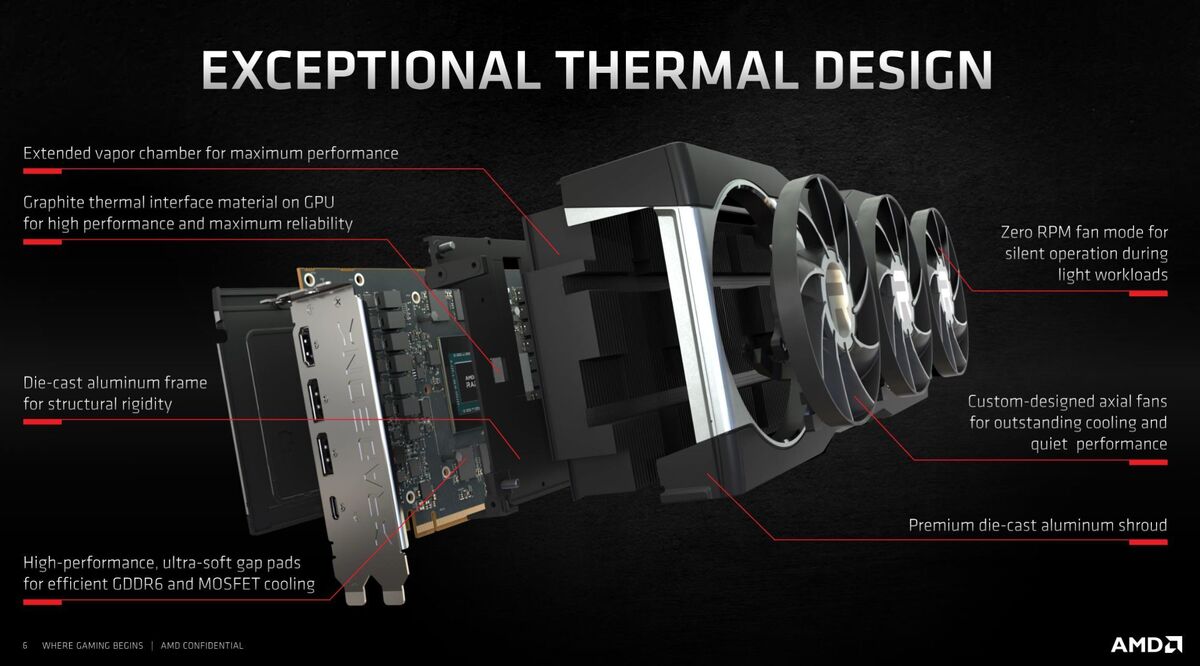 AMD
AMDBeyond the aluminum shroud, the trio of 90mm fans on the Radeon RX 6800 and 6800 XT include a zero-rpm fan mode. That means they turn on only when the GPU is stressed, so the cards stay silent when you’re web-browsing and doing other light work. AMD also used a graphite thermal material instead of the thermal paste you’d normally find between the GPU die and the heat sink; the company says it won’t degrade over time like traditional paste does.
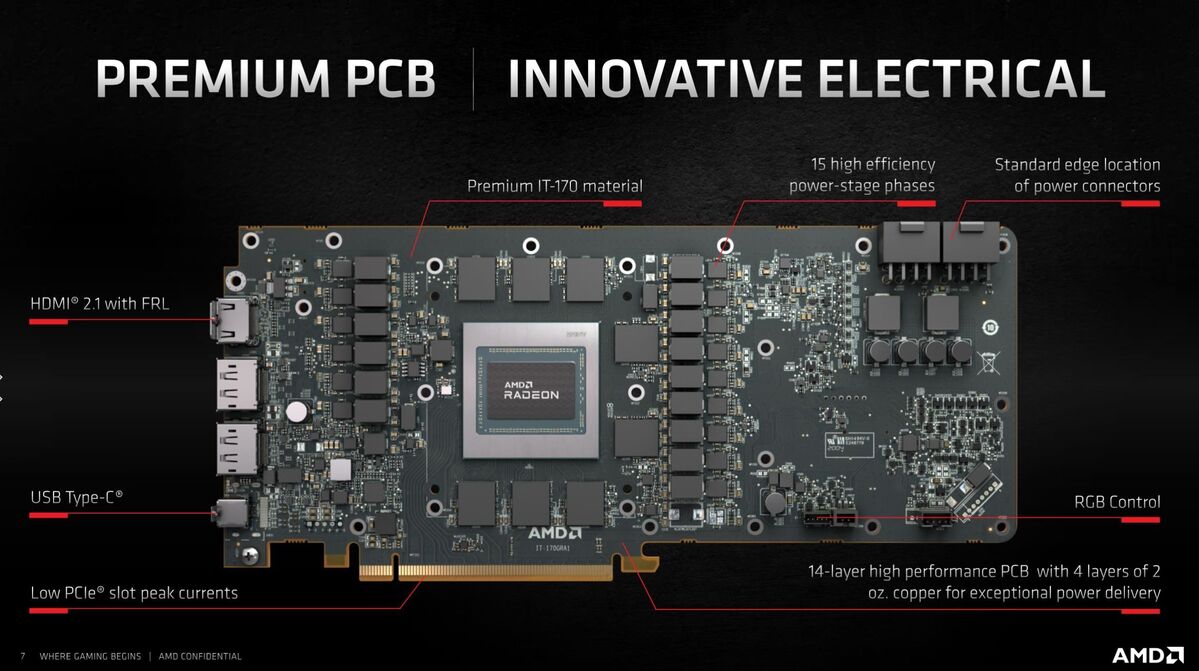 AMD
AMDAMD used a 14-layer PCB built from “premium” IT-170 material to ensure reliable signal integrity given the GPU’s sky-high clock speeds, and it equipped the Radeon RX 6800-series GPUs with 15 high-efficiency power phases. The power phases paired to the GDDR6 memory aren’t as robust as what you’ll see on competing boards, but that’s not a bad thing. Once again, Infinity Cache is the reason.
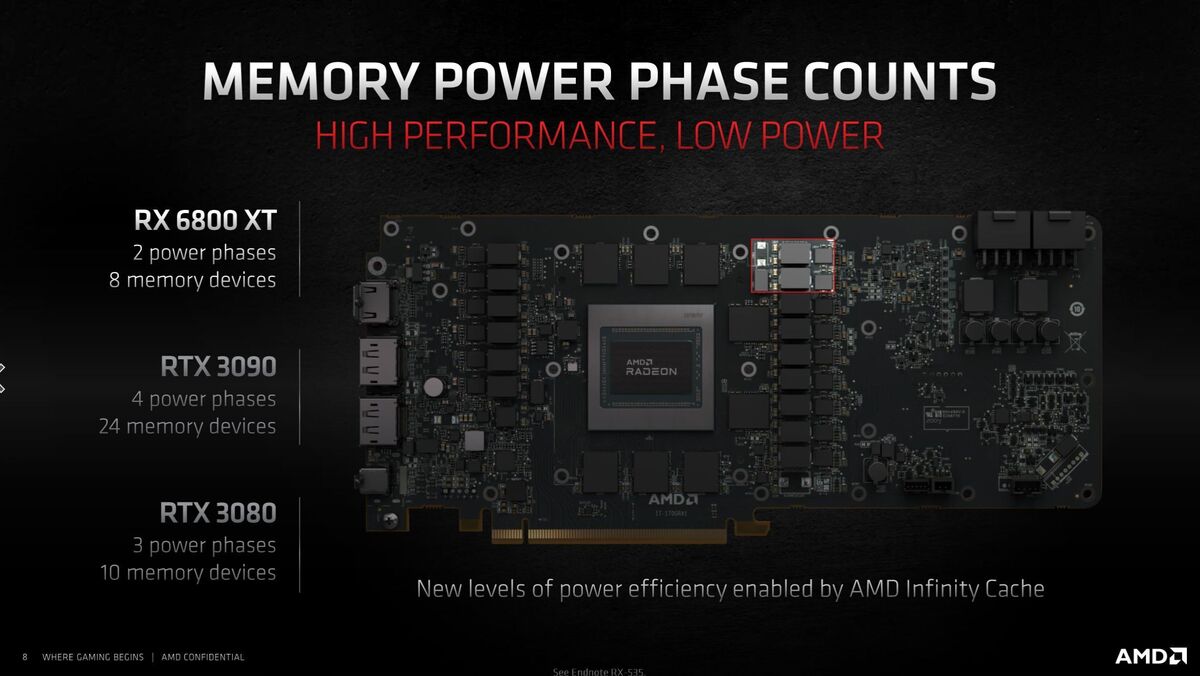 AMD
AMD“Because we can store more information on-die, there are fewer required memory transactions,” AMD Fellow Laura Smith said in a briefing for reporters. “We also selected dual-density GDDR6 memory. The combination of these two choices allow us to deliver performance with only two phases for each of the eight memory devices. Leveraging the Infinity Cache, and this thoughtful design point, we can give lots of headroom for overclocking with an efficient board layout.”
 Brad Chacos/IDG
Brad Chacos/IDG AMD
AMD
Encode and decode supported on the Radeon RX 6000-series GPUs.
On the rear of the card you’ll find dual Displayports, a USB-C port that can be used with displays and compatible VR headsets alike, and a single HDMI 2.1 connection with variable refresh rate support. By comparison, Nvidia omitted a USB-C port from its RTX 30-series cards after including it on the 20-series, claiming that it wasn’t used much. AMD’s upgrade to HDMI 2.1 means you can drive a 60Hz 8K display or a speedy 144Hz 4K monitor with a single cable, a feature that pairs nicely with RDNA 2’s newfound AV1 decode support, which enables stutter-free streaming of 8K videos.
Next page: Smart Access Memory
Better with Ryzen: AMD Smart Access Memory
With Ryzen and Radeon finally both firing on all cylinders, AMD decided to unlock capabilities that help the Radeon RX 6000-series achieve even higher frame rates when it’s paired with a Ryzen 5000-series processor in an X570 motherboard.
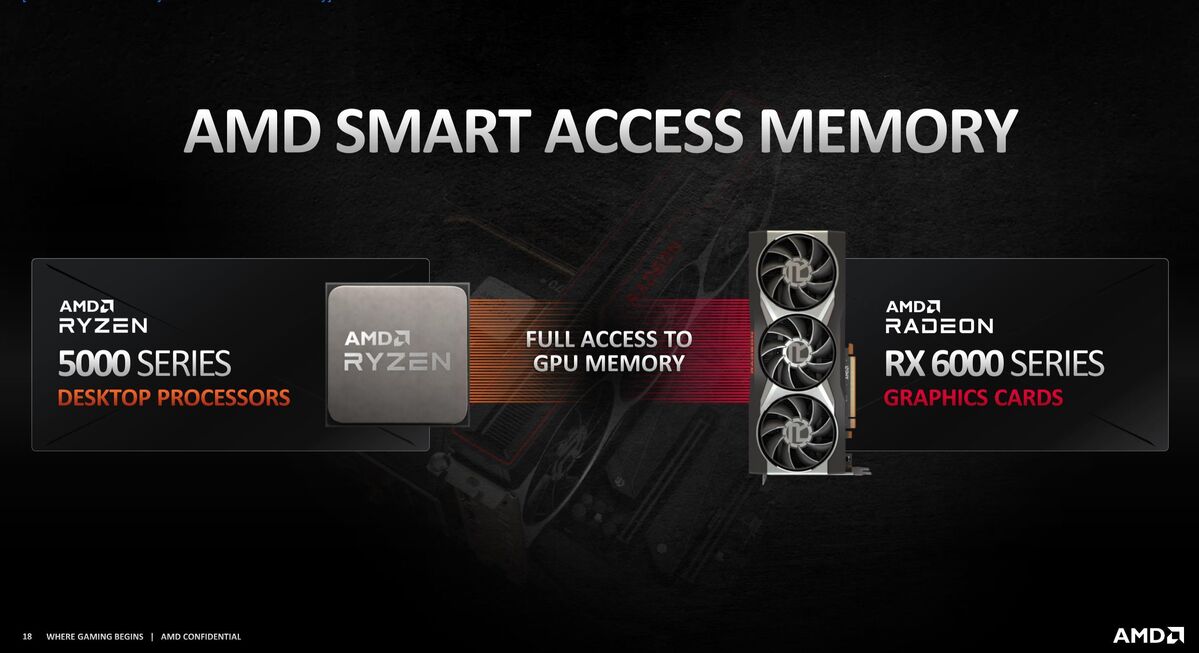 AMD
AMDSmart Access Memory gives the CPU full access to the GPU’s memory, rather than limiting it to the usual 256MB chunks. That unrestricted access to the data channel can improve gaming performance. Going off AMD’s numbers, however, the uplift can vary greatly between games, resolutions, and which Radeon RX 6000-series GPU you use.
In the chart below, which AMD included in its reviewers’ guide, Battlefield V and Hitman 2 didn’t get any extra performance at 1080p resolution with Smart Access Memory enabled, but saw a slight uptick as the pixel count moved up. Other games displayed the opposite behavior, delivering a bigger performance uplift at 1080p versus 4K—look at Borderland 3, Resident Evil 3, and Red Dead Redemption 2.
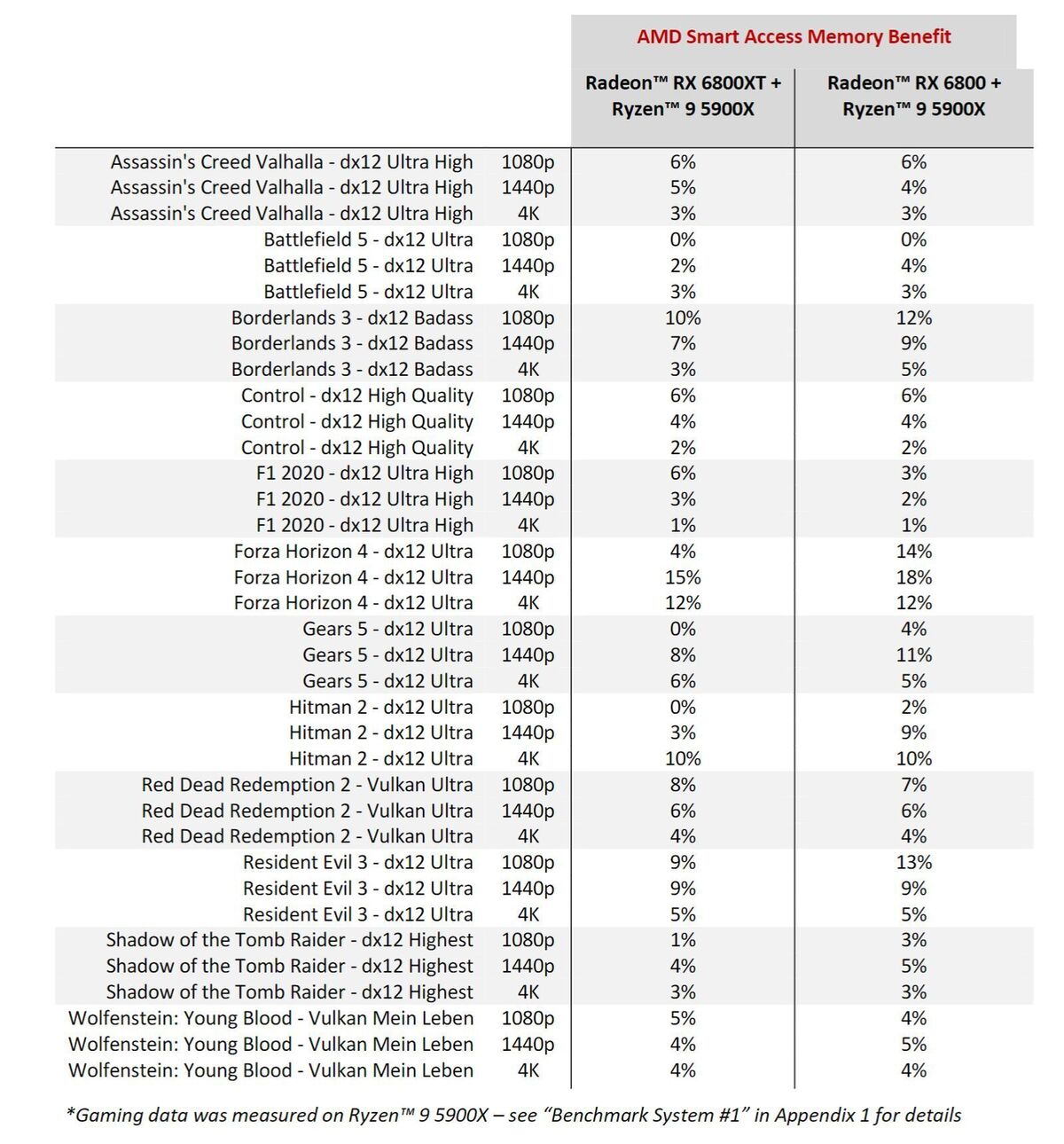 AMD
AMD
AMD-supplied benchmark data for Smart Access Memory.
It’s interesting how the less-powerful Radeon RX 6800 generally—but again, not universally—tends to see a bigger performance increase with Smart Access Memory enabled, and that all of the games AMD tested use modern “close to the metal” APIs like Vulkan and DirectX 12. None of the games here run on the much more common DirectX 11 API. Are Smart Access Memory’s benefits lessened or negated in DX11? I’d hoped to give the technology a whirl ourselves, but motherboard shipping delays crushed the plans. Stay tuned for a follow-up in the coming days.
Smart Access Memory can’t be used by everyone, though. You need a Ryzen 5000-series processor and a compatible X570 motherboard that has had its BIOS updated to support AMD’s AGESA 1.1.0.0 firmware, along with a current version of Radeon Software (which you need to run the Radeon RX 6800-series anyway) and a 64-bit operating system. For now, X570 motherboards won’t enable Smart Access Memory by default; you need to dive into your BIOS’s advanced settings and activate both “Above 4G Decoding” and “Re-size BAR support” to coax it into working. AMD expects AM4 motherboard makers to turn on Smart Access Memory by default going forward.
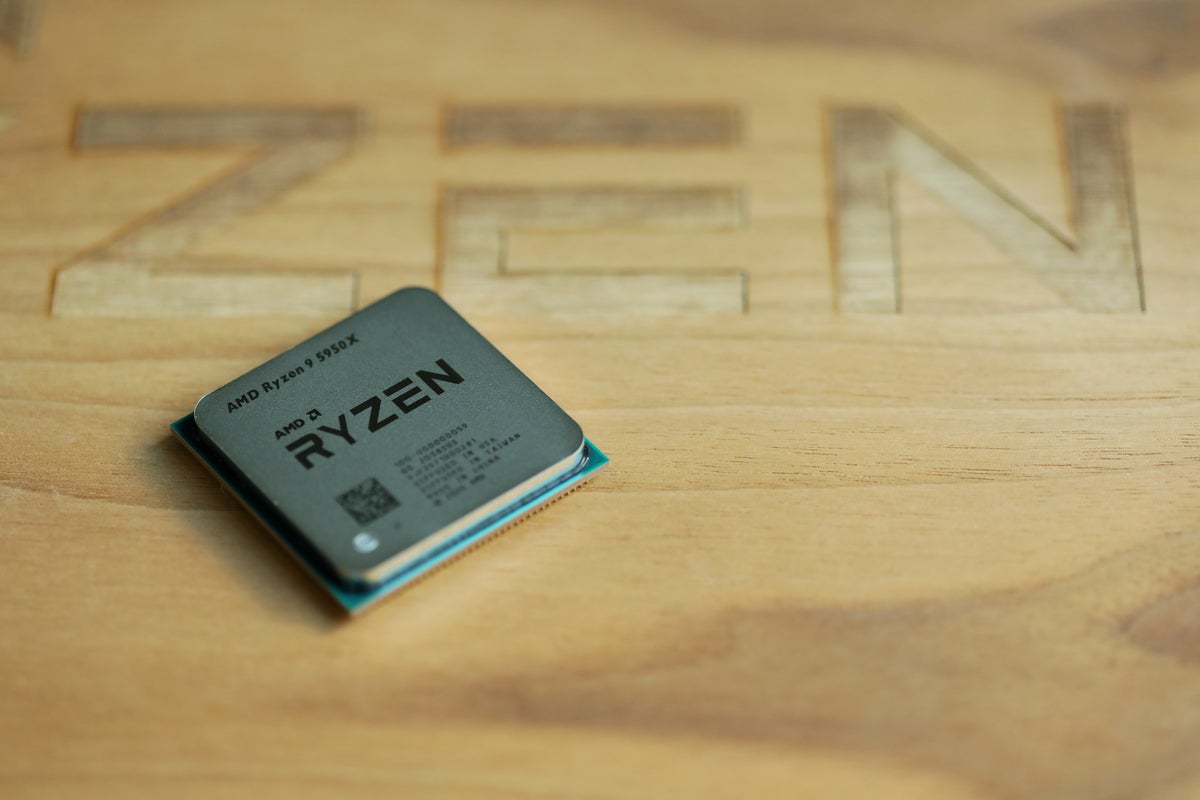 Gordon Mah Ung
Gordon Mah Ung
You need a Ryzen 5000-series processor like this 5900X to use Smart Access Memory.
Note that terminology—“Re-size BAR support,” and not “Smart Access Memory.” Resizable BAR functionality is part of the PCIe Express specification, but it hasn’t often been used, especially on Windows. Smart Access Memory is basically AMD branding for enabling Resizable BAR with some additional driver optimizations on top. Smart Access Memory serves as a cornerstone for AMD’s “Ultimate Gaming Platform” pitch for pairing Ryzen and Radeon, but if the gains mostly come from resizeable BAR, AMD could activate it on other hardware—and Intel and Nvidia, for that matter.
Nvidia has already reached out to PCWorld to say it’s working to enable PCIe Resizeable BAR on its GeForce GPUs, with promising results already in its labs. Nvidia claims the technology works with both PCIe 3.0 and PCIe 4.0, and could work with any processor platform that also supports it. In other words, if Nvidia flipped on resizeable BAR in GeForce cards, it should work with Ryzen 5000 chips just as well as Radeon RX 6000-series GPUs do, unless AMD blocks it in some way.
Don’t let that diminish what AMD accomplished with its “Ultimate Gaming Platform” here, though. Yes, resizeable BAR has been a part of PCIe for a while, but it hadn’t been used before. Enabling the technology requires the processor, motherboard, and graphics card to all join in on the party—something AMD is uniquely positioned to do as a supplier of both CPUs and GPUs. Smart Access Memory should just work when you put a Radeon RX 6800 into a Ryzen 5000 system with a new X570 motherboard. Older X570 motherboards require a BIOS upgrade to get SAM running. If Intel or Nvidia decided to enable Resizeable BAR, it would likely require BIOS updates for all of that hardware as well. While updating your firmware isn’t as scary as it used to be, it’s still far more complicated than simply downloading a new driver.
I wouldn’t be surprised if Nvidia and Intel indeed supported Resizeable BAR in the future now that AMD’s dragged it into the light. But expect Smart Access Memory to be a key AMD advantage until its rivals start enabling it by default.
Enough scene-setting. Let’s get to the benchmarks.
Next page: Our test system, gaming benchmarks begin
Our test system
Our dedicated graphics card test system is a couple of years old, but it’s packed with some of the fastest complementary components available to put any potential performance bottlenecks squarely on the GPU, especially at the higher resolution these graphics cards target. Most of the hardware was provided by the manufacturers, but we purchased the cooler and storage ourselves.
- Intel Core i7-8700K processor ($300 on Amazon) overclocked to 5GHz all cores
- EVGA CLC 240 closed-loop liquid cooler ($105 on Amazon)
- Asus Maximus X Hero motherboard
- 64GB HyperX Predator RGB DDR4/2933 ($355 on Amazon)
- EVGA 1200W SuperNova P2 power supply ($352 on Amazon)
- Corsair Crystal 570X RGB case, with front and top panels removed and an extra rear fan installed for improved airflow
- 2x 500GB Samsung 860 EVO SSDs ($70 each on Amazon)
We’re comparing the $579 Radeon RX 6800 and $649 Radeon RX 6800 XT against their direct Nvidia rivals, the $500 GeForce RTX 3070 and $700 GeForce RTX 3080. We’re also adding results for the last-gen GeForce RTX 2080 Ti, RTX 2080, and RTX 2070. We included AMD’s most powerful RDNA 1 offering, the $400 Radeon RX 5700 XT. All are reference cards or Nvidia Founders Edition models. (If you want to see how the RTX Super offerings or older GTX 1080 and 1080 Ti cards perform in these games, you can find that data in our RTX 3080 review.)
We test a variety of games spanning various engines, genres, vendor sponsorships (Nvidia, AMD, and Intel), and graphics APIs (DirectX 11, DX12, and Vulkan). Each game is tested using its in-game benchmark at the highest possible graphics presets unless otherwise noted, with VSync, frame rate caps, real-time ray tracing or DLSS effects, and FreeSync/G-Sync disabled, along with any other vendor-specific technologies like FidelityFX tools or Nvidia Reflex. We’ve also enabled temporal anti-aliasing (TAA) to push these cards to their limits. We run each benchmark at least three times and list the average result for each test.
Radeon RX 6800 and 6800 XT gaming benchmarks
Watch Dogs: Legion
Watch Dogs: Legion is one of the first games to debut on next-gen consoles. Ubisoft upgraded its Disrupt engine to include cutting-edge features like real-time ray tracing and Nvidia’s DLSS. We disable those effects for this testing, but e with its optional high-resolution texture pack installed, Legion remains a strenuous game even on high-end hardwar. No card can maintain a 60 frames-per-second average with Ultra graphics options enabled, and the game uses more than 8GB of memory even at 1440p. Oof.
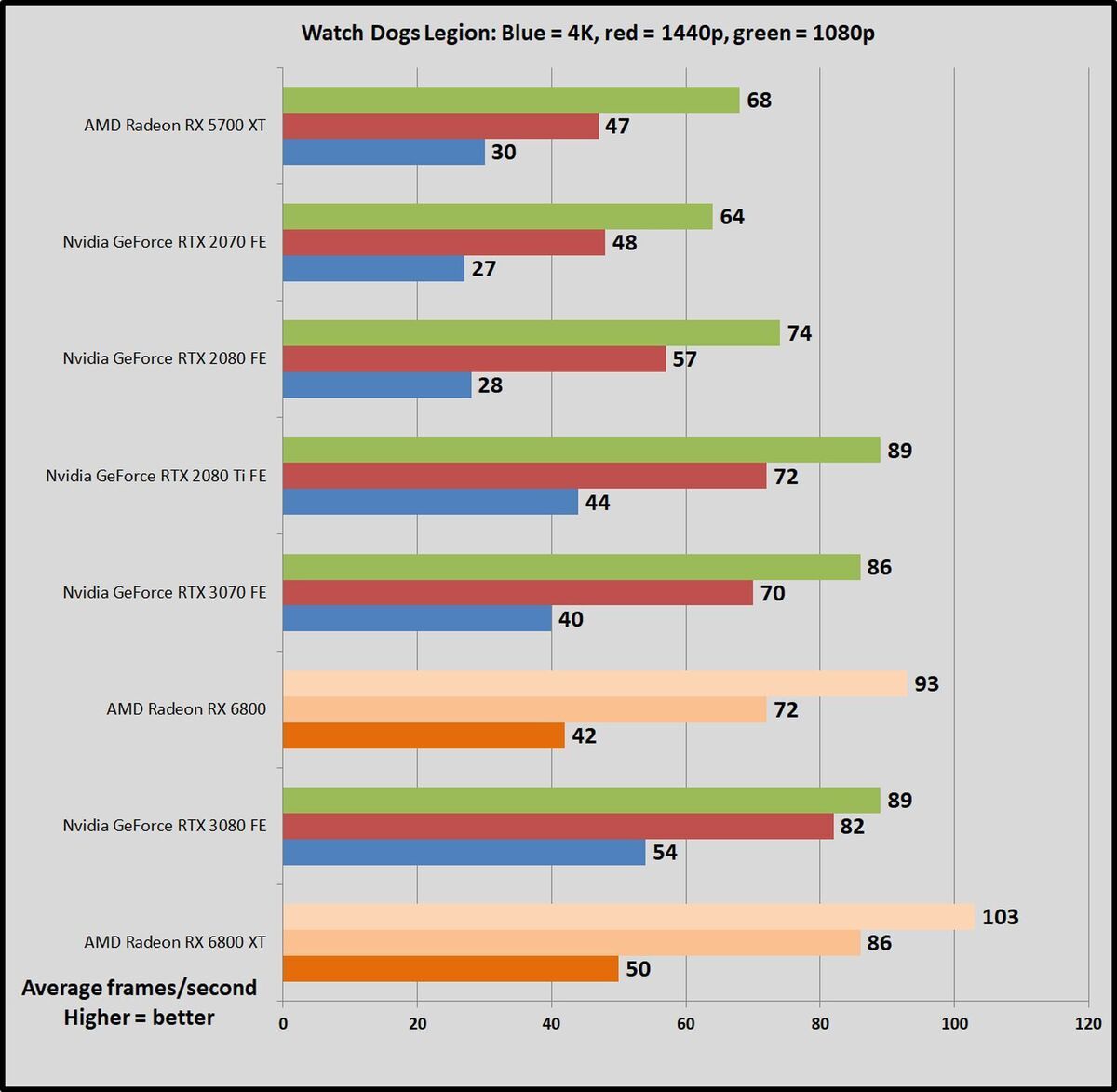 Brad Chacos/IDG
Brad Chacos/IDGThis Nvidia-sponsored title already reveals some differences in how games behave on modern GeForce and Radeon GPUs. The Radeon RX 6800 is just barely ahead of the RTX 3070 at 4K and 1440p resolution, but roars ahead of even the RTX 3080 at 1080p. The pricier Radeon RX 6800 XT, on the other hand, is a few frames behind the RTX 3080 at 4K resolution, but takes a just-as-slim lead at 1440p, which explodes into a beat-down at 1080p.
Horizon Zero Dawn
Yep, PlayStation exclusives are coming to the PC now. Horizon Zero Dawn runs on Guerrilla Games’ Decima engine, the same engine that powers Death Stranding. Ambient Occlusion can offer iffy results if set to Ultra, so we test with that setting at Medium. Every other visual option is maxed out.
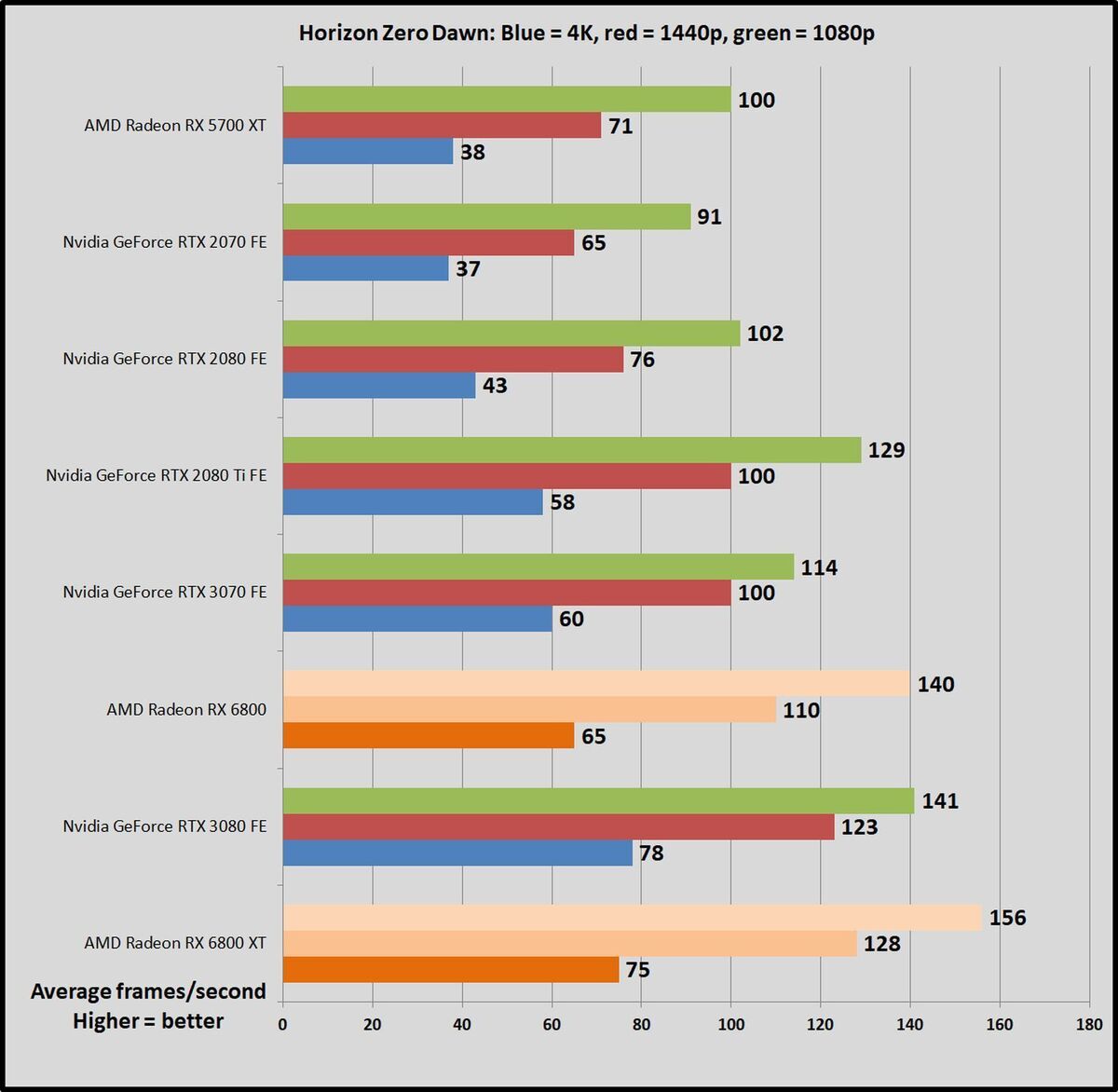 Brad Chacos/IDG
Brad Chacos/IDGAMD continues to flex at more common resolutions here. The Radeon RX 6800 is 8 percent faster than the RTX 3070 at 4K, 10 percent faster at 1440p, and a whopping 22 percent faster at 1080p. Once again, the Radeon RX 6800 XT winds up a few frames behind the RTX 3080 at 4K resolution, but it takes the lead by 4 percent at 1440p and leaps ahead by 10 percent at 1080p.
Gears Tactics
Gears Tactics puts it own brutal, fast-paced spin on the XCOM-like genre. This Unreal Engine 4-powered game was built from the ground up for DirectX 12, and we love being able to work a tactics-style game into our benchmarking suite. Better yet, the game comes with a plethora of graphics options for PC snobs. More games should devote such loving care to explaining what flipping all these visual knobs mean. You can’t use the presets to benchmark Gears Tactics, as it intelligently scales to work best on your installed hardware, meaning that “Ultra” on one graphics card can load different settings than “Ultra” on a weaker card. We manually set all options to their highest possible settings.
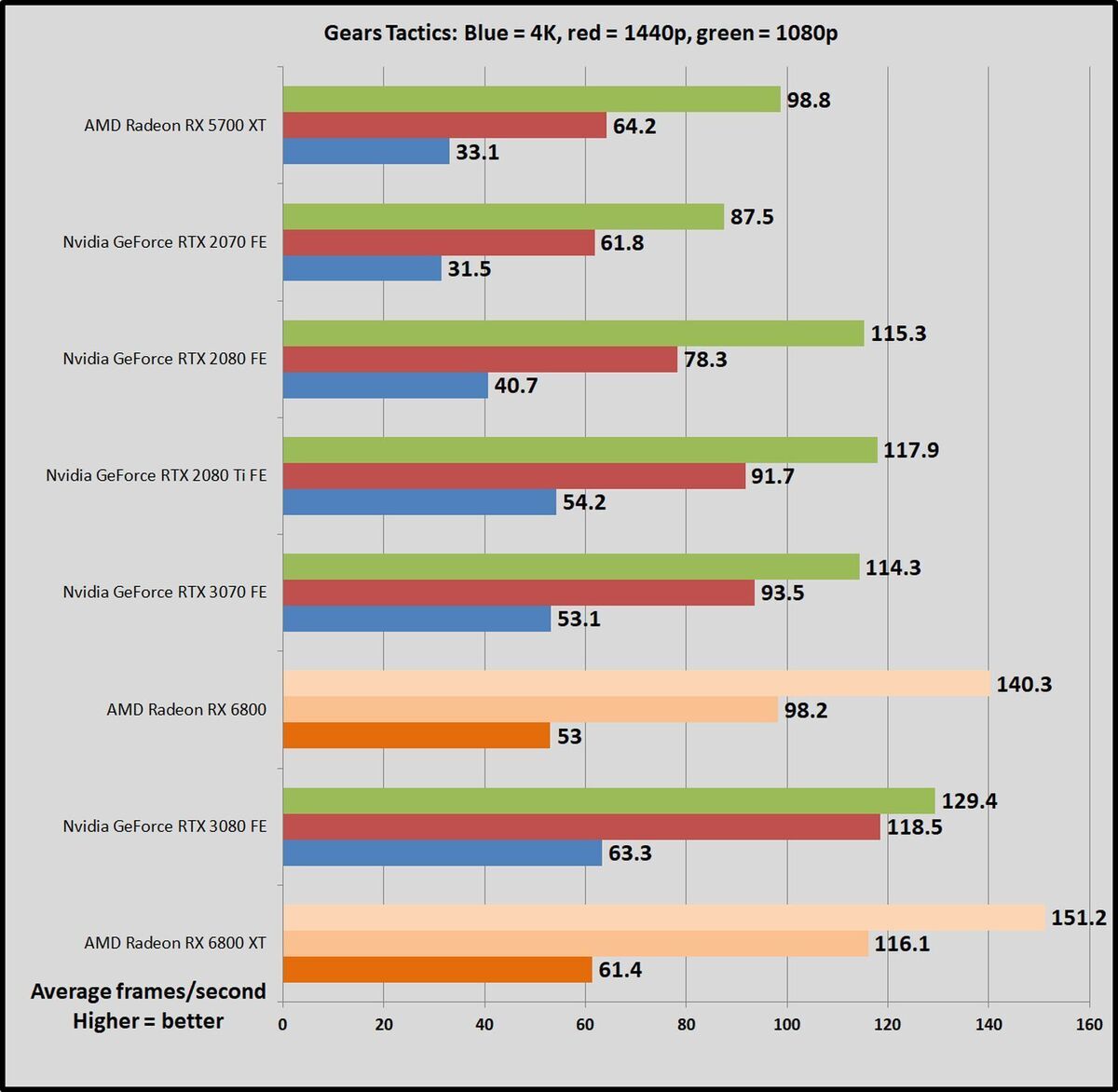 Brad Chacos/IDG
Brad Chacos/IDGOkay, now it’s a trend. The Radeon RX 6800 slugs it out with the RTX 3070 at 4K, but holds a 5 percent advantage at 1440p, and a whopping 23 percent lead at 1080p. The Radeon RX 6800 XT trades blows with the RTX 3080 at 4K and 1440p, but leaps ahead by 17 percent at 1080p.
Next page: Gaming benchmarks continue
Wolfenstein: Youngblood
Wolfenstein: Youngblood is most fun when you can play cooperatively with a buddy, but it’s a fearless experiment—and an absolute technical showcase. Running on the Vulkan API, Youngblood achieves blistering frame rates, and it supports all sorts of cutting-edge technologies like ray tracing, DLSS 2.0, HDR, GPU culling, asynchronous computing, and Nvidia’s Content Adaptive Shading. The game includes a built-in benchmark with two different scenes; we tested Lab X.
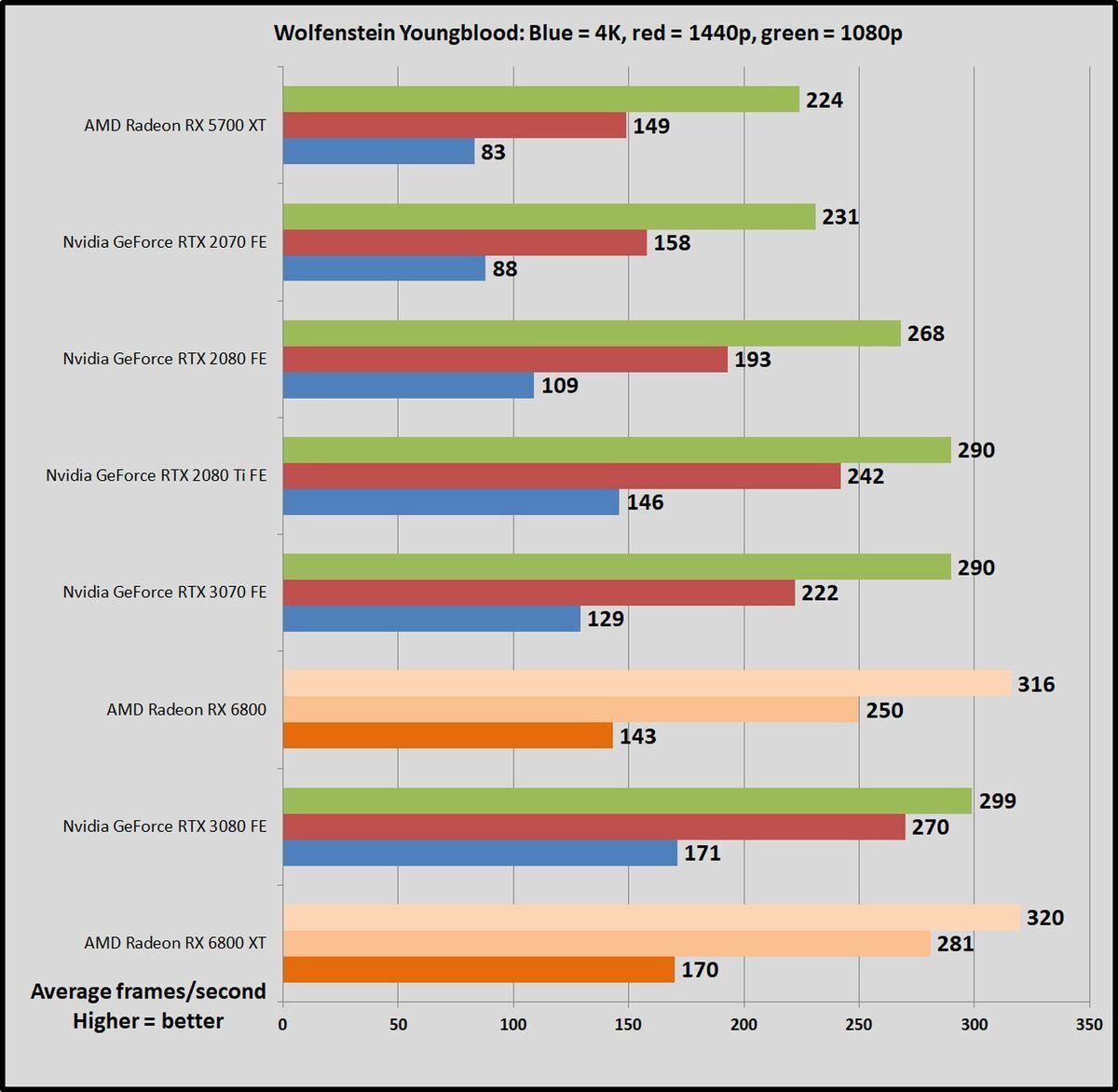 Brad Chacos/IDG
Brad Chacos/IDGThis is another Nvidia-sponsored title, but Radeon takes the edge more often than not. The Radeon RX 6800 is 11 percent faster than the RTX 3070 at 4K and 13 percent faster at 1440p, though it falls to a 9-percent win at 1080p simply because the graphics card is so powerful there that we’re hitting some sort of CPU or engine bottleneck. The Radeon RX 6800 XT once again delivers performance equal to the RTX 3080 at 4K and widens the gap the lower the resolution goes, before hitting the same soft cap as the Radeon RX 6800, at around 320 fps at 1080p.
Metro Exodus
One of the best games of 2019, Metro Exodus is one of the best-looking games around, too. The latest version of the 4A Engine provides incredibly luscious, ultra-detailed visuals, with one of the most stunning real-time ray tracing implementations released yet. We test in DirectX 12 mode with ray tracing, Hairworks, and DLSS disabled for our basic benchmarks.
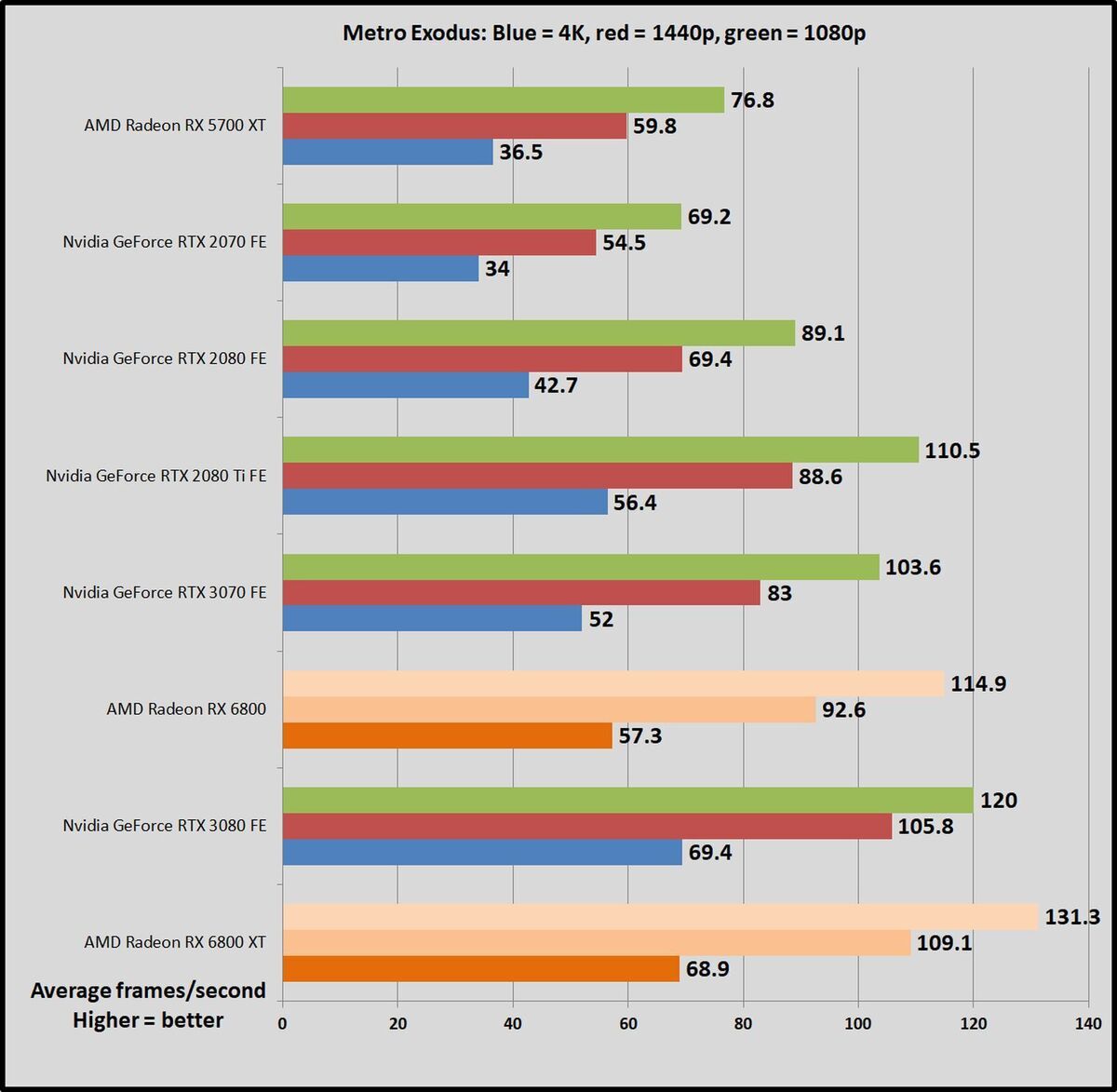 Brad Chacos/IDG
Brad Chacos/IDGFinally, a consistent result. The Radeon RX 6800 is 10 percent faster than the RTX 3070 at 4K, 12 percent faster at 1440p, and 11 percent faster at 1080p. For more context, the $579 Radeon RX 6800 is essentially as fast as the $700 RTX 3080 at 1080p. The step-up Radeon RX 6800 XT extends the lead over the RTX 3080 even further, as you’d expect, after once again equaling it at 4K and drawing slightly ahead at 1440p.
Borderlands 3
Borderlands is back! Gearbox’s game defaults to DX12, so we do as well. It gives us a glimpse at the ultra-popular Unreal Engine 4’s performance in a traditional shooter.
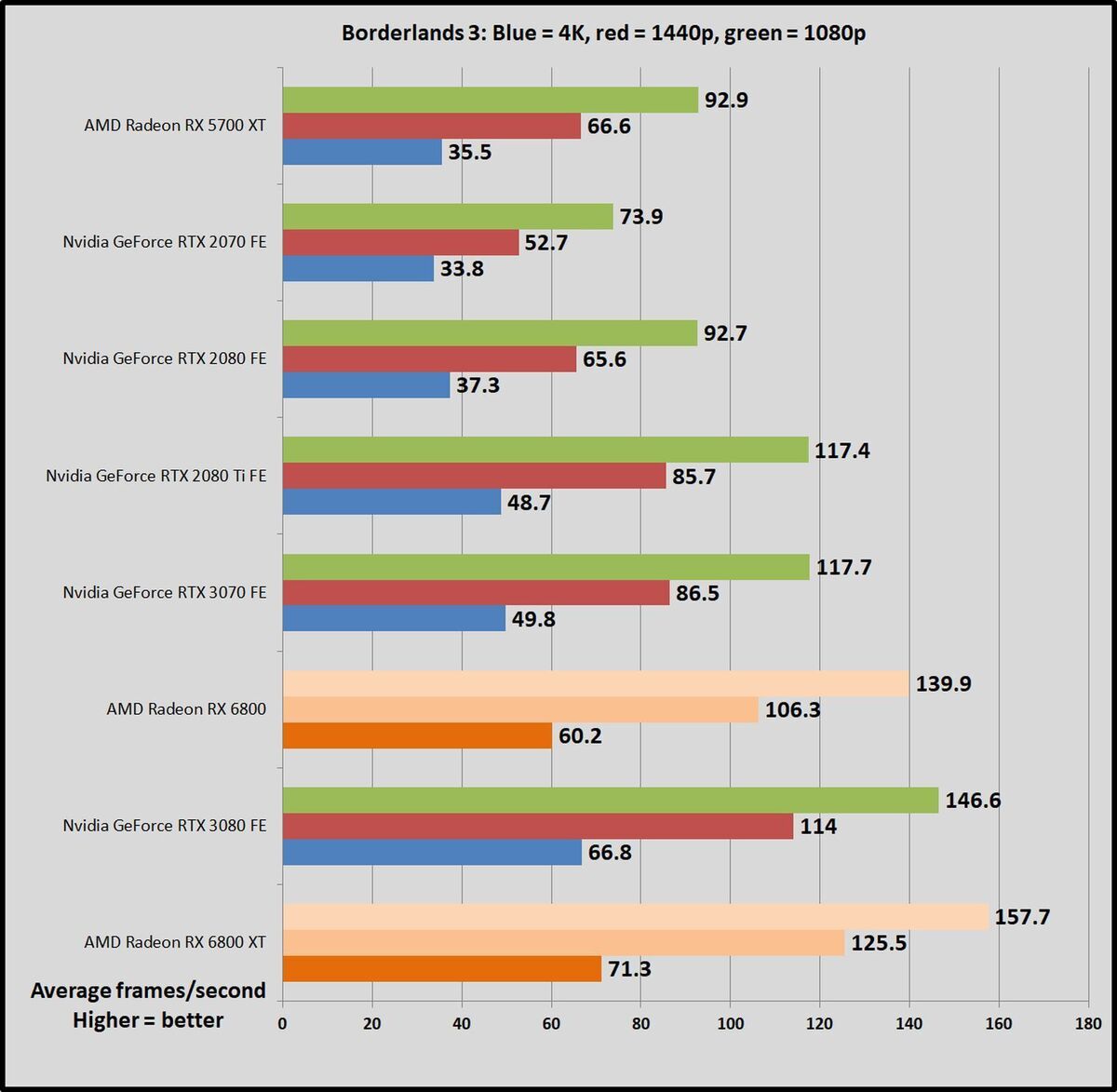 Brad Chacos/IDG
Brad Chacos/IDGStop, stop, he’s already dead. The Radeon RX 6800 slaughters the RTX 3070, kicking things off with a healthy 20 percent performance lead at 4K and only widening the gap from there. The Radeon RX 6800 XT beats the RTX 3080 across the board as well, albeit by a much smaller margin.
Strange Brigade
Strange Brigade is a cooperative third-person shooter where a team of adventurers blasts through hordes of mythological enemies. It’s a technological showcase, built around the next-gen Vulkan and DirectX 12 technologies and infused with features like HDR support and the ability to toggle asynchronous compute on and off. It uses Rebellion’s custom Azure engine. We test using the Vulkan renderer, which is faster than DX12.
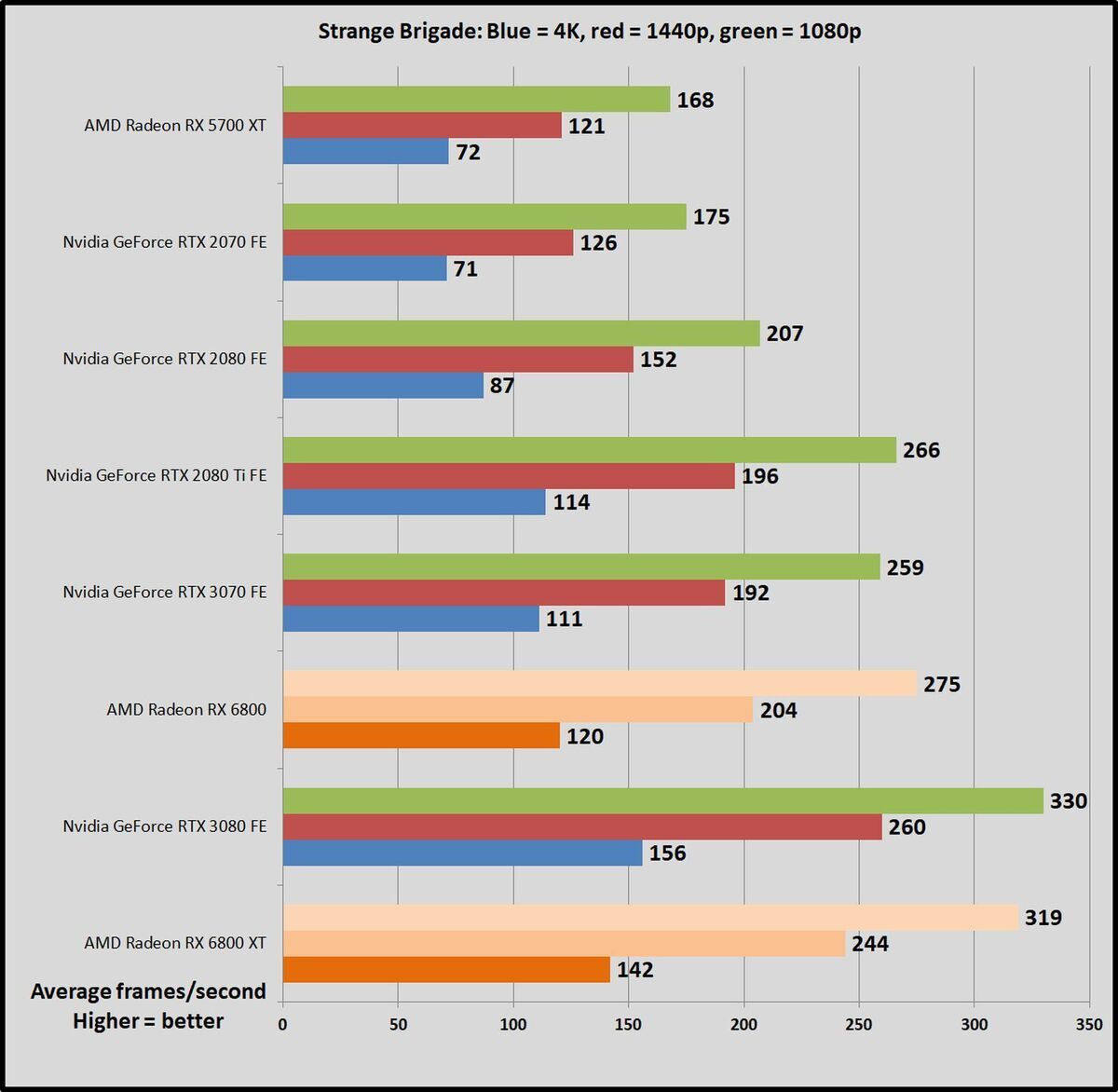 Brad Chacos/IDG
Brad Chacos/IDGTwo new Radeon cards, two very different results. The Radeon RX 6800 tromps all over the RTX 3070 once again, but the RTX 3080 beats the RX 6800 XT at all resolutions. Still, the same overall trend continues: Nvidia’s lead is largest at 4K, with a 9-percent advantage, and the gap narrows as you go down in pixel count.
Next page: Gaming benchmarks continue
Total War: Troy
The latest game in the popular Total War saga, Troy was given away free for its first 24 hours on the Epic Games Store, moving over 7.5 million copies before it went on proper sale. Total War: Troy is built using a modified version of the Total War: Warhammer 2 engine, and this DX11 title looks stunning for a turn-based strategy game. We test the more intensive battle benchmark.
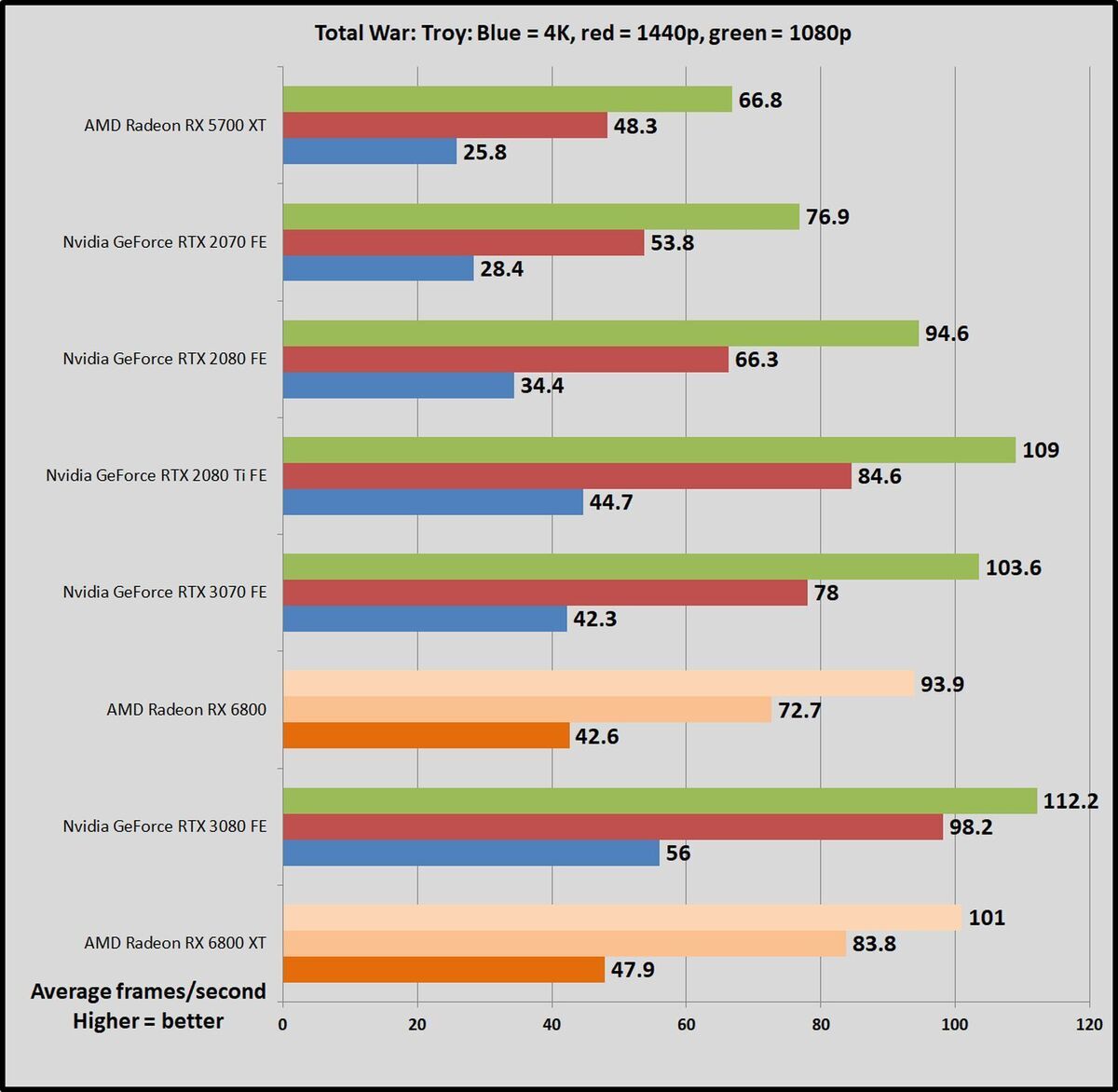 Brad Chacos/IDG
Brad Chacos/IDGStop, stop, he’s already dead. For whatever reason, Total War: Troy vastly prefers Nvidia’s Ampere architecture to AMD’s RDNA 2. The Radeon RX 6800 hangs tougher than its bigger sibling, but this game is a resounding win for GeForce.
F1 2020
The latest in a long line of successful racing games, F1 2020 is a gem to test, supplying a wide array of both graphical and benchmarking options, making it a much more reliable (and fun) option that the Forza series. It’s built on the latest version of Codemasters’ buttery-smooth Ego game engine, complete with support for DX12 and Nvidia’s DLSS technology. We test two laps on the Australia course, with clear skies on and DLSS off.
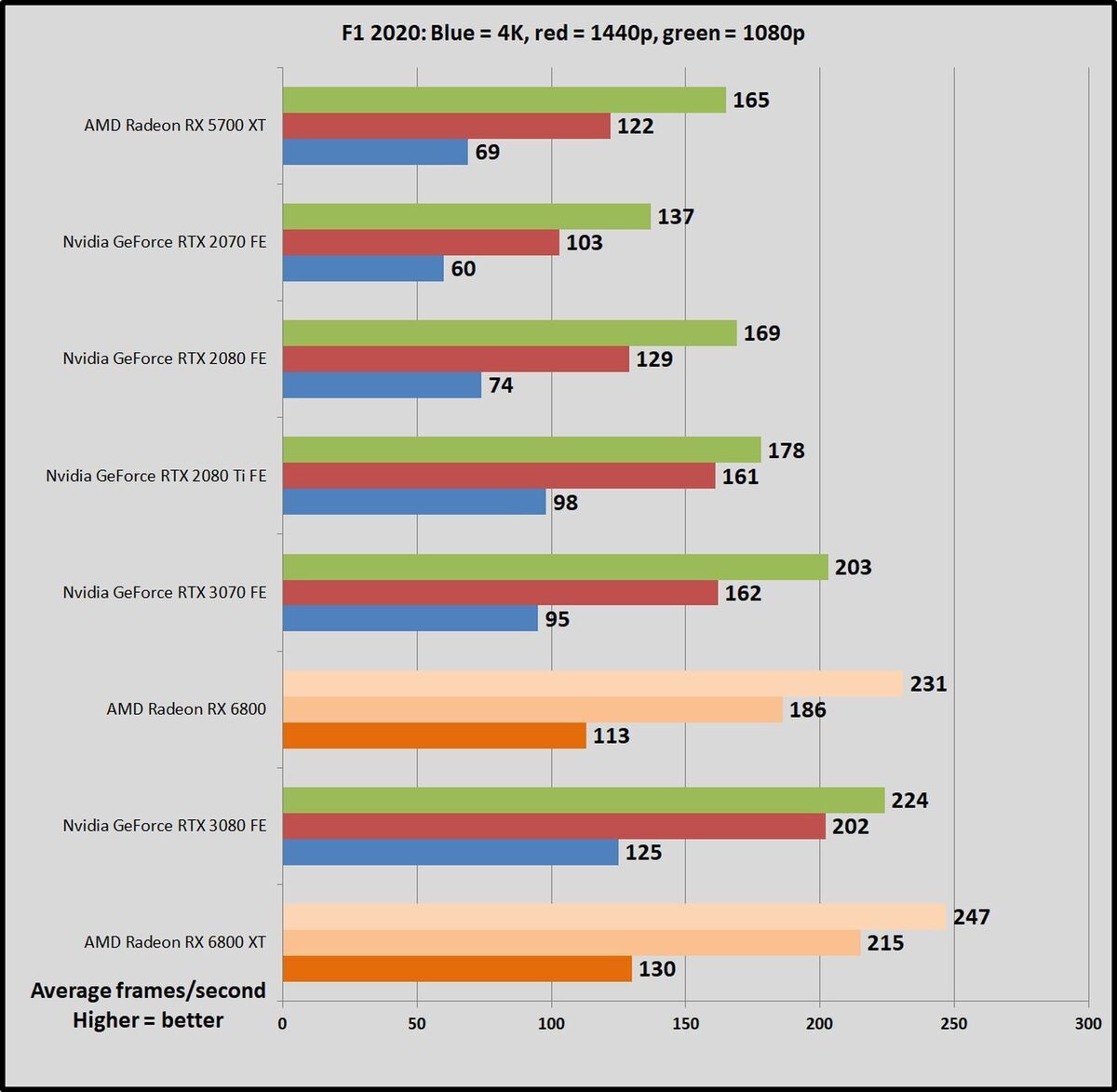 Brad Chacos/IDG
Brad Chacos/IDGHere the tables flip again, with both Radeon GPUs seizing uncontested victories at all resolutions. The Radeon RX 6800 even manages a stunning 19-percent win over the RTX 3070 at 4K.
Shadow of the Tomb Raider
Shadow of the Tomb Raider concludes the reboot trilogy, and it’s utterly gorgeous. Square Enix optimized this game for DX12, and recommends DX11 only if you’re using older hardware or Windows 7, so we test with DX12. Shadow of the Tomb Raider uses an enhanced version of the Foundation engine that also powered Rise of the Tomb Raider and includes optional real-time ray tracing and DLSS features.
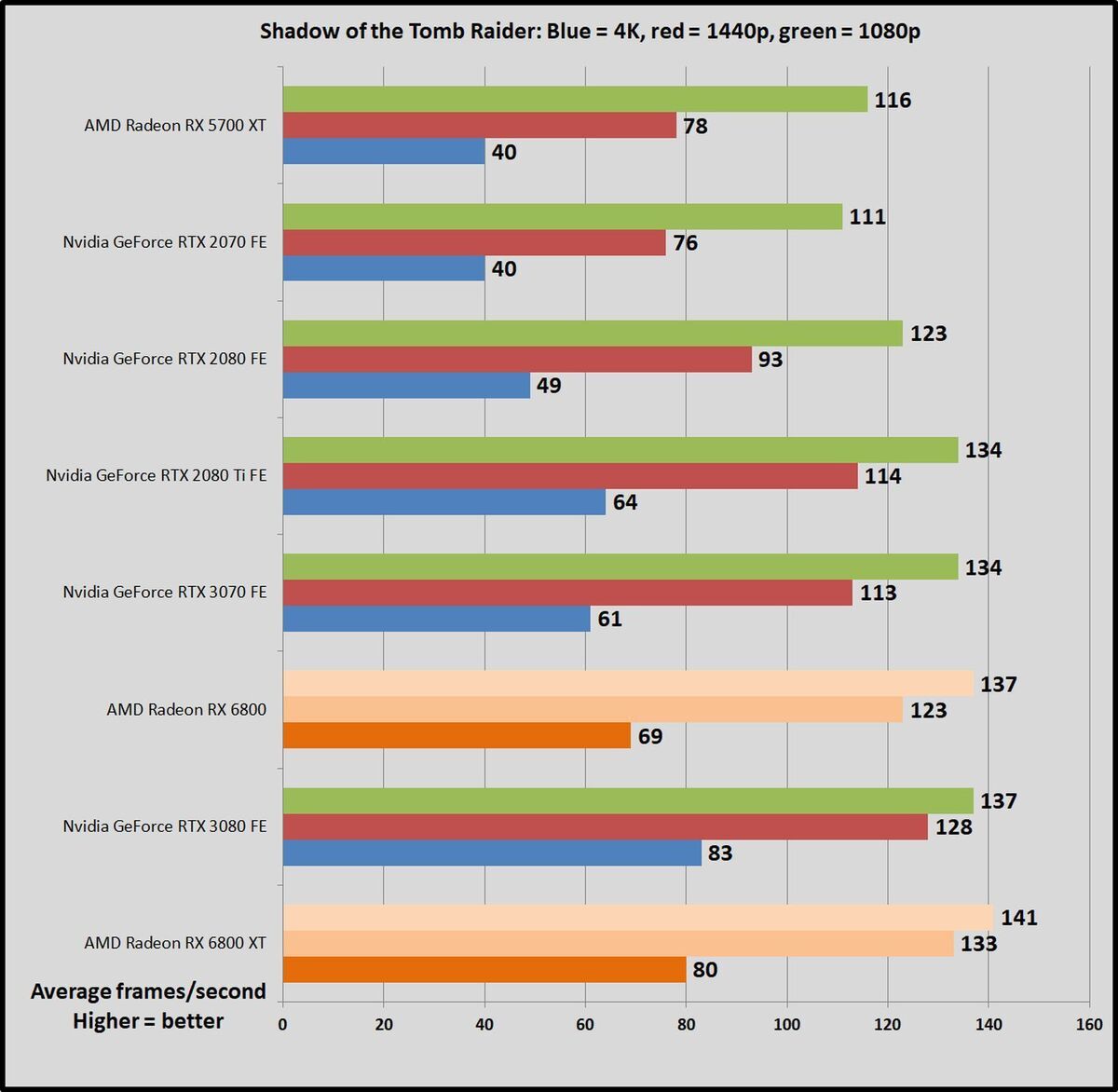 Brad Chacos/IDG
Brad Chacos/IDGAll of these graphics cards start to hit a CPU or engine bottleneck at 1080p, delivering largely identical performance. Beyond that, the trends we’ve largely observed remain the same.
GTA V
This DX11 game that isn’t really a visual barn-burner like the (somewhat wonky) Red Dead Redemption 2, but it still tops the Steam charts day in and day out, so we deem it more worthy of testing. RDR2 will melt your graphics card, sure, but GTA V remains so popular years after launch that upgraded versions of it will be available on the next-generation consoles. That’s staying power.
We test Grand Theft Auto V with all options turned to Very High, all Advanced Graphics options except extended shadows enabled, and FXAA. GTA V runs on the RAGE engine and has received substantial updates since its initial launch.
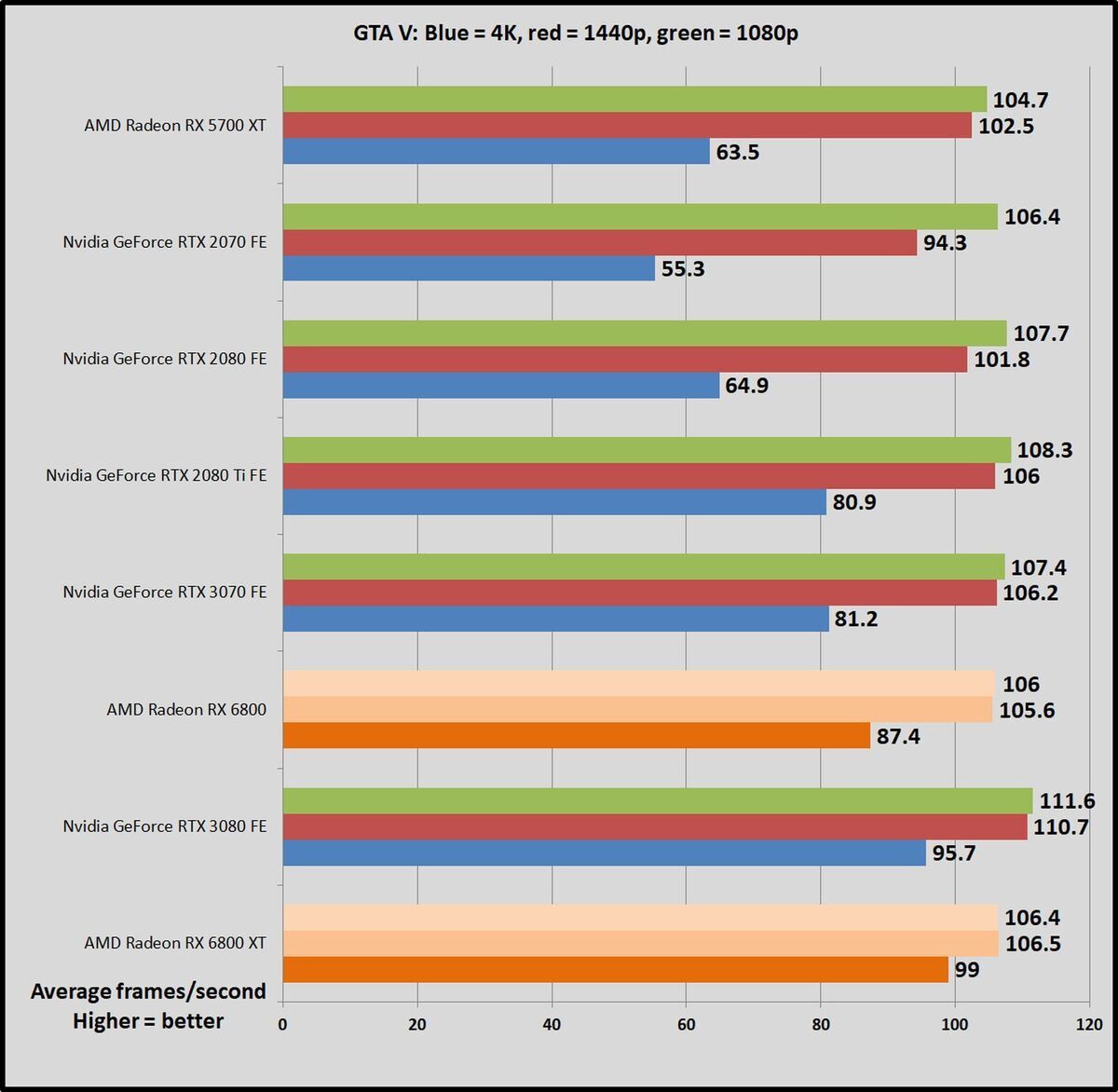 Brad Chacos/IDG
Brad Chacos/IDGThis game won’t be included in our reviews going forward, as any top-end GPU is fast enough to hit bottlenecks at both 1080p and 1440p now. At 4K, the Radeon RX 6800 is a bit faster than the RTX 3070, and the Radeon RX 6800 XT is a bit faster than the RTX 3080.
Rainbow Six Siege
Like GTA V, Ubisoft’s Rainbow Six Siege still dominates the Steam charts years after its launch, and it’ll be getting a visual upgrade for the next-gen consoles. The developers have poured a ton of work into the game’s AnvilNext engine over the years, eventually rolling out a Vulkan version of the game that we use to test. By default, the game lowers the render scaling to increase frame rates, but we set it to 100 percent to benchmark native rendering performance on graphics cards. Even still, frame rates soar.
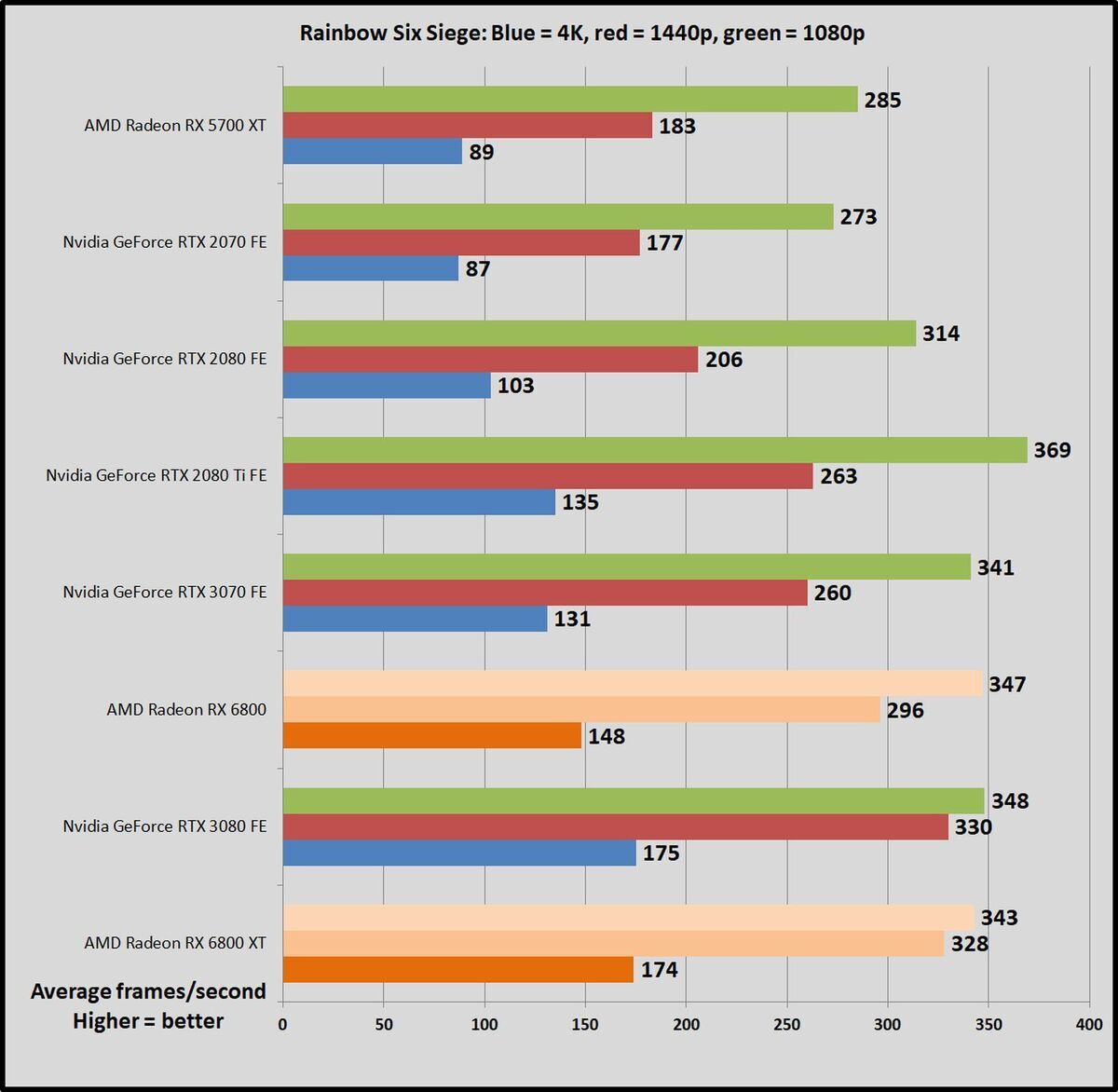 Brad Chacos/IDG
Brad Chacos/IDGOnce again, all of the high-end cards being compared here hit CPU or engine bottlenecks at 1080p, with every option landing around 345 fps. The Radeon RX 6800 is about 13 percent faster than the RTX 3070 at both 4K and 1440p, while the Radeon RX 6800 XT and RTX 3080 deliver essentially equal performance across the board.
Next page: Radeon RX 6800 and 6800 XT ray tracing performance
Radeon RX 6800 and 6800 XT ray tracing performance
Now let’s dig a bit deeper into the newfound real-time ray tracing capabilities of AMD’s graphics cards.
RDNA 2 marks the debut of ray tracing capabilities in Radeon graphics chips. Nvidia first introduced the technology in the GeForce RTX 20-series, and is now on its second-generation effort with the RTX 30-series. As you’d expect, Nvidia’s more mature technology delivers more performance, but how much more performance? We decided give Watch Dogs: Legion, Metro: Exodus and Shadow of the Tomb Raider a whirl to put it to the test. Hopefully we’ll be able to revisit the topic with a wider selection of games later—the gorgeous Godfall didn’t include ray tracing at launch, alas—but for now, this trio of games represents a decent selection of various ray tracing effects. Legion packs ray-traced reflections, Tomb Raider includes ray-traced shadows, and Metro features more strenuous (and mood-enhancing) ray-traced global illumination.
Complicating things further is DLSS. Nvidia’s Deep Learning Super Sampling feature renders games at a lower resolution, then taps into dedicated tensor cores that use AI to upscale the final image to your resolution. Because the game is being rendered at lower resolution, your graphics card’s traditional shading hardware can pump out frames faster, while DLSS’s AI delivers shockingly good final quality. Well, now at least. DLSS 1.0 suffered from some birthing pains, as covered in our RTX 20-series ray tracing retrospective, but the new DLSS 2.0 algorithms work beautifully.
Bottom line, though? DLSS is a key Nvidia advantage right now, especially if you’re interested in playing games with ray tracing active. AMD targeted playable 1440p performance with ray tracing enabled on the Radeon RX 6800-series and largely hit those goals, but DLSS helps Nvidia’s cards hit much higher frame rates, and even lets you play ray-traced games at 4K. AMD can’t match that. The company has teased a “FidelityFX Super Resolution” feature that it hopes will rival DLSS and gain more traction given RDNA 2’s inclusion in the next-gen consoles, but it’s not here yet.
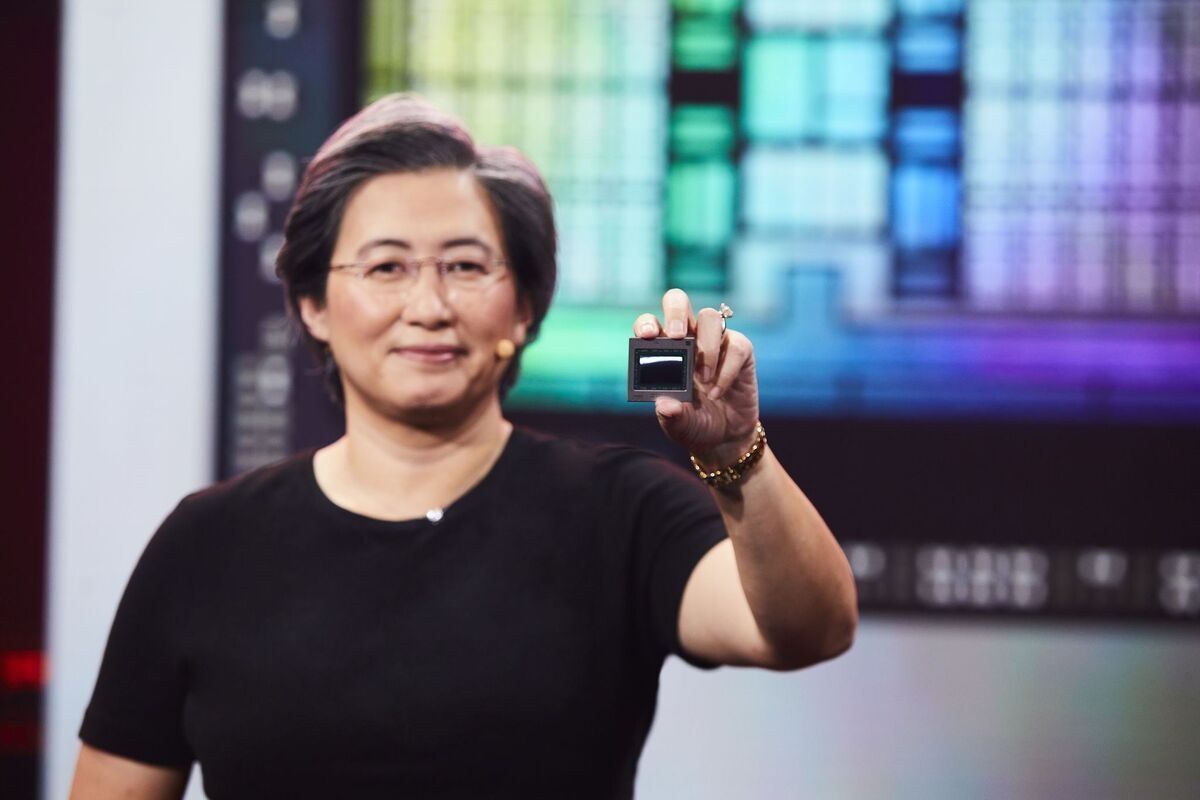 AMD
AMD
RDNA 2 is AMD’s first graphics architecture to support real-time ray tracing.
It’s also worth noting that since the Khronos group’s ray tracing support for Vulkan hasn’t been officially released yet, any Vulkan games that currently support the technology were built using Nvidia extensions as a band-aid in the interim. That means you can’t enable ray tracing in Wolfenstein: Youngblood, Quake II RTX, or the Asian title JX3 on the Radeon GPUs, at least for now. The option doesn’t even appear in Youngblood. All other ray-traced games were built using Microsoft’s DirectX Raytracing API, however, so they should work just fine on both GeForce and Radeon hardware. Yes, that includes Cyberpunk 2077.
We’ve included three charts for each game—one for each major resolution. We split the results into several charts because we wanted to show native performance, performance with only ray tracing on, and performance with ray tracing and DLSS on (for Nvidia cards) at each resolution to get a more complete picture of things. We set ray tracing to ultra for all titles; using lower settings will have less of an impact.
Let’s kick things off with Shadow of the Tomb Raider’s ray-traced shadows. The game includes the first-generation version of DLSS and doesn’t support 1080p resolution, so we’ve stuck to raw ray tracing performance.
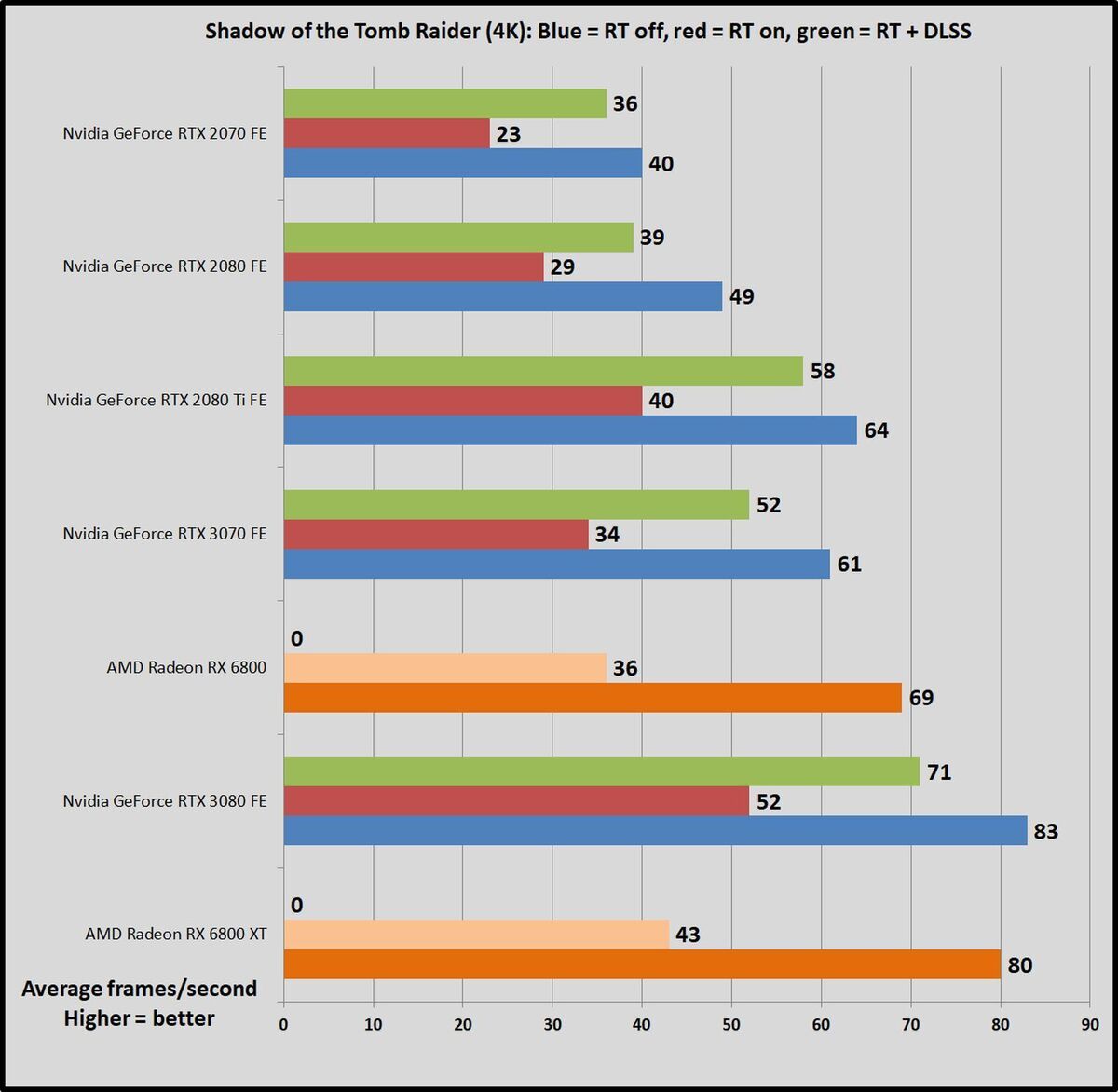 Brad Chacos/IDG
Brad Chacos/IDG Brad Chacos/IDG
Brad Chacos/IDG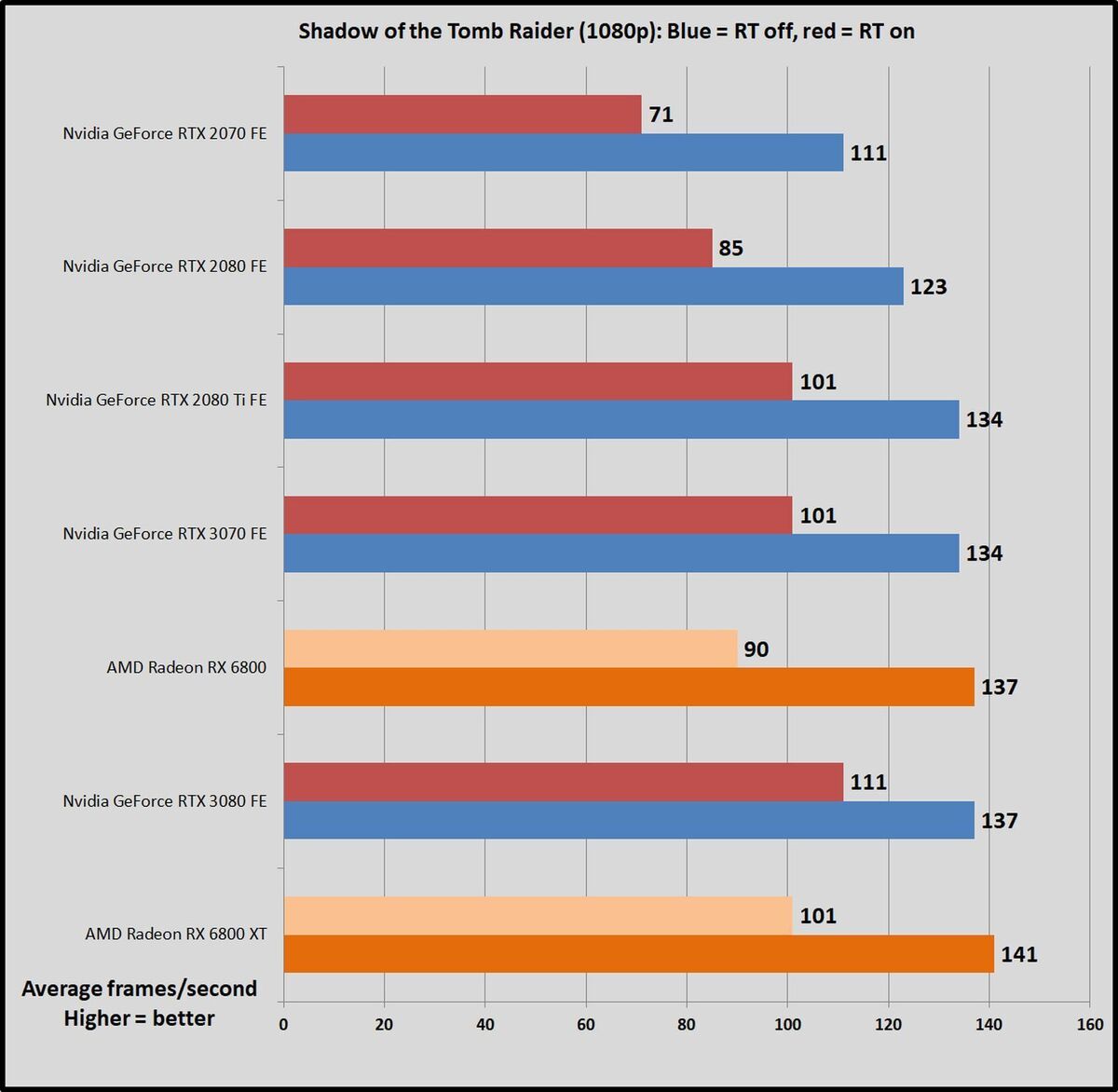 Brad Chacos/IDG
Brad Chacos/IDGFlipping on ray tracing creates a big performance impact, as you’d expect, but it’s bigger on Radeon GPUs. As you can see, even though the AMD cards perform faster than their GeForce rivals with ray tracing off, they have slower performance with ray tracing on. Ray tracing slows the Radeon RX 6800 XT down by 41 percent at 1440p, and the Radeon RX 6800 by 46 percent. By contrast, Nvidia’s RTX 3070 slows down 37 percent with ray tracing active, and the RTX 3080 slows down only 28 percent.
The Radeon RX 6800 and 6800 XT exceed the hallowed 60-fps mark at 1440p resolution and clear 90 fps at 1080p. Flipping on DLSS gives Nvidia a massive performance lead, however, and it delivers enough extra oomph to let you play the game at 4K resolution on GeForce hardware. You won’t be able to do that with the Radeon RX 6800-series unless you dial back some visual settings.
Metro: Exodus uses ray tracing for global illumination. It also uses DLSS 1.0 and doesn’t support the upscaling feature at 1080p, so we’ve included only raw ray tracing performance on that chart.
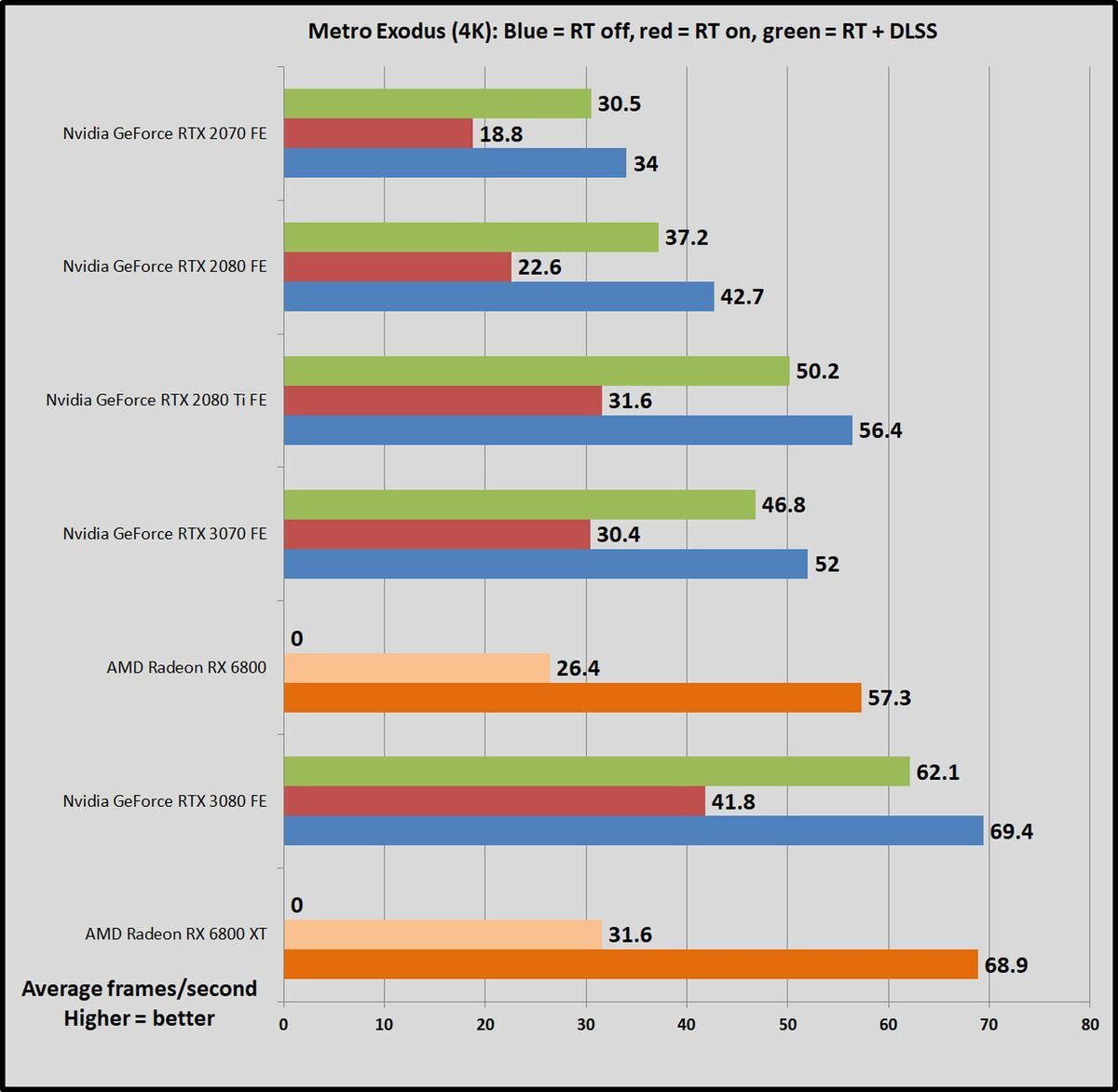 Brad Chacos/IDG
Brad Chacos/IDG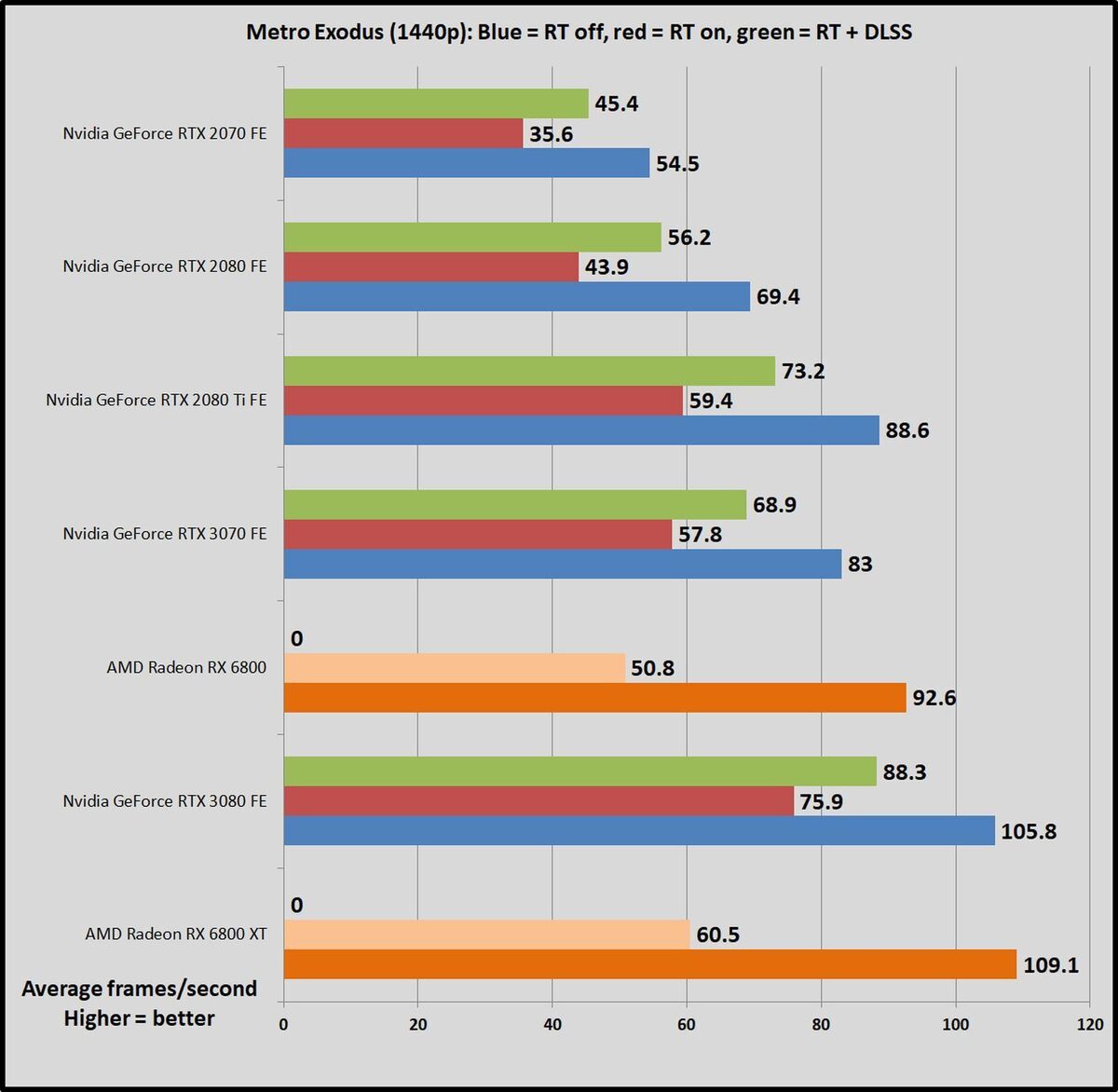 Brad Chacos/IDG
Brad Chacos/IDG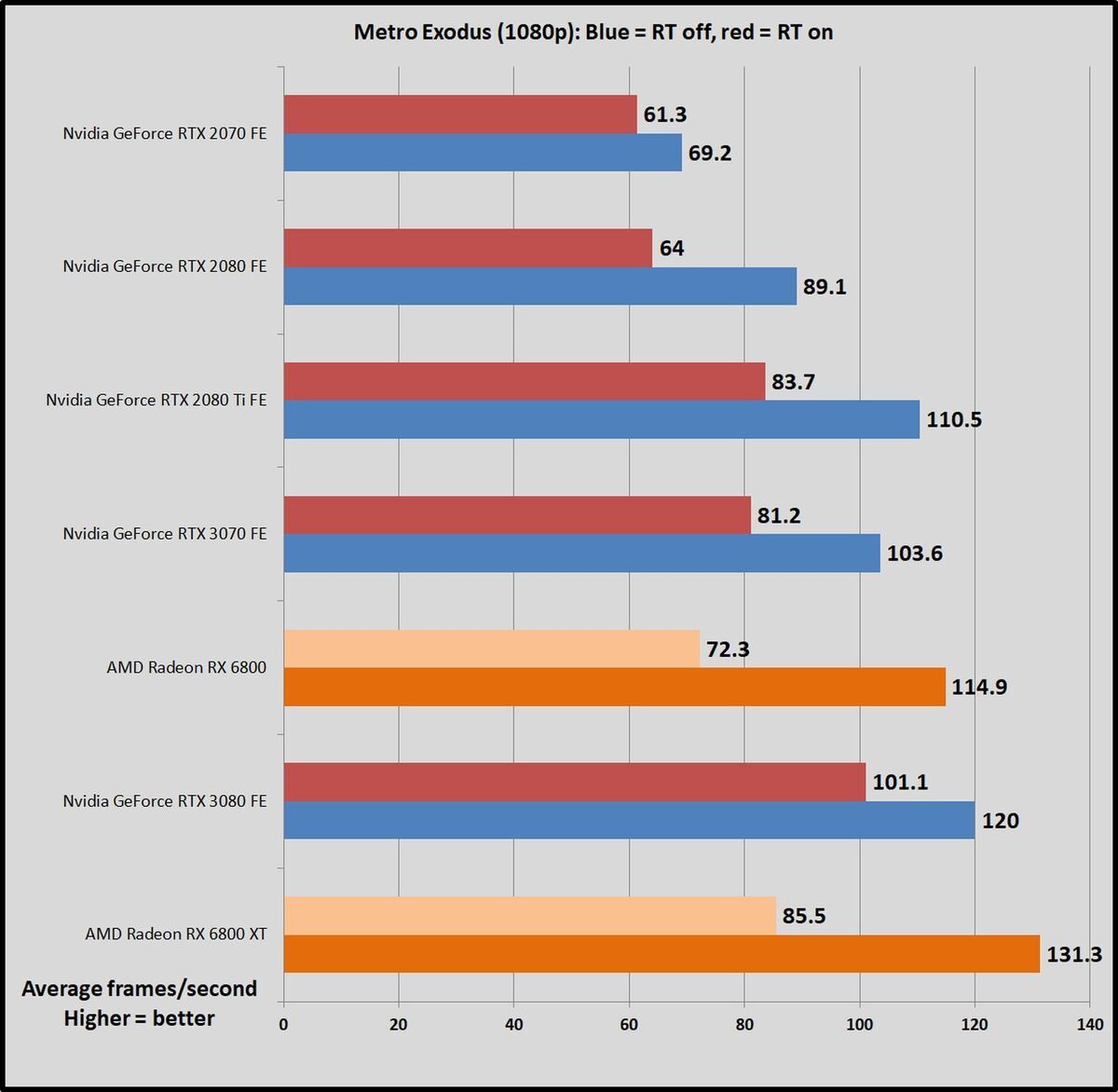 Brad Chacos/IDG
Brad Chacos/IDGRay tracing reduces the performance on both Radeon RX 6800-series cards by 45 percent at 1440p. The RTX 3080 only loses 28 percent off the top, while the RTX 3070 loses 30 percent. Flipping on DLSS once again extends Nvidia’s lead. That said, the Radeon GPUs indeed achieve playable frame rates at 1440p and 1080p, though you will need to tinker with some visual settings to hit 60 fps at 1440p. GeForce cards can leverage DLSS to play with ray tracing on at all resolutions, though you’ll also need to tweak some things to get them running at 60 fps at 4K.
Watch Dogs: Legion hammers your system regardless of whether you have ray tracing on. None of these cards sustain 60 fps at 4K resolution even with the cutting-edge lighting effects turned off, at least with the high-resolution texture pack installed. Activating the ray-traced reflections exacerbates the issue. Unlike Tomb Raider and Metro, Watch Dogs uses the faster, better DLSS 2.0 technology. We test it with DLSS Balanced mode active. Balanced lets you hit higher frame rates than the Quality mode, but the even faster Performance mode starts to introduce visual differences you can notice in some scenes. Balanced hits the sweet spot.
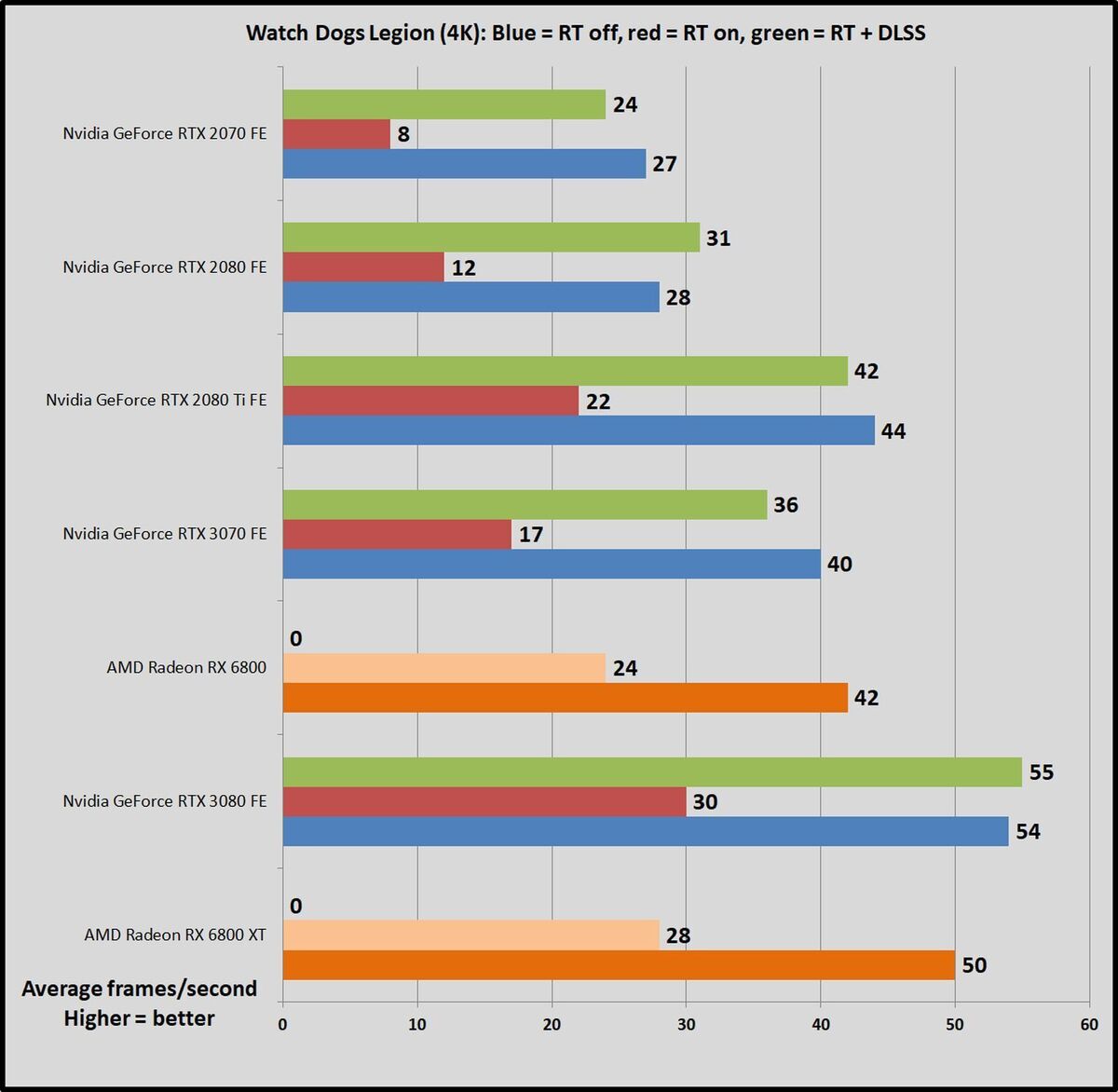 Brad Chacos/IDG
Brad Chacos/IDG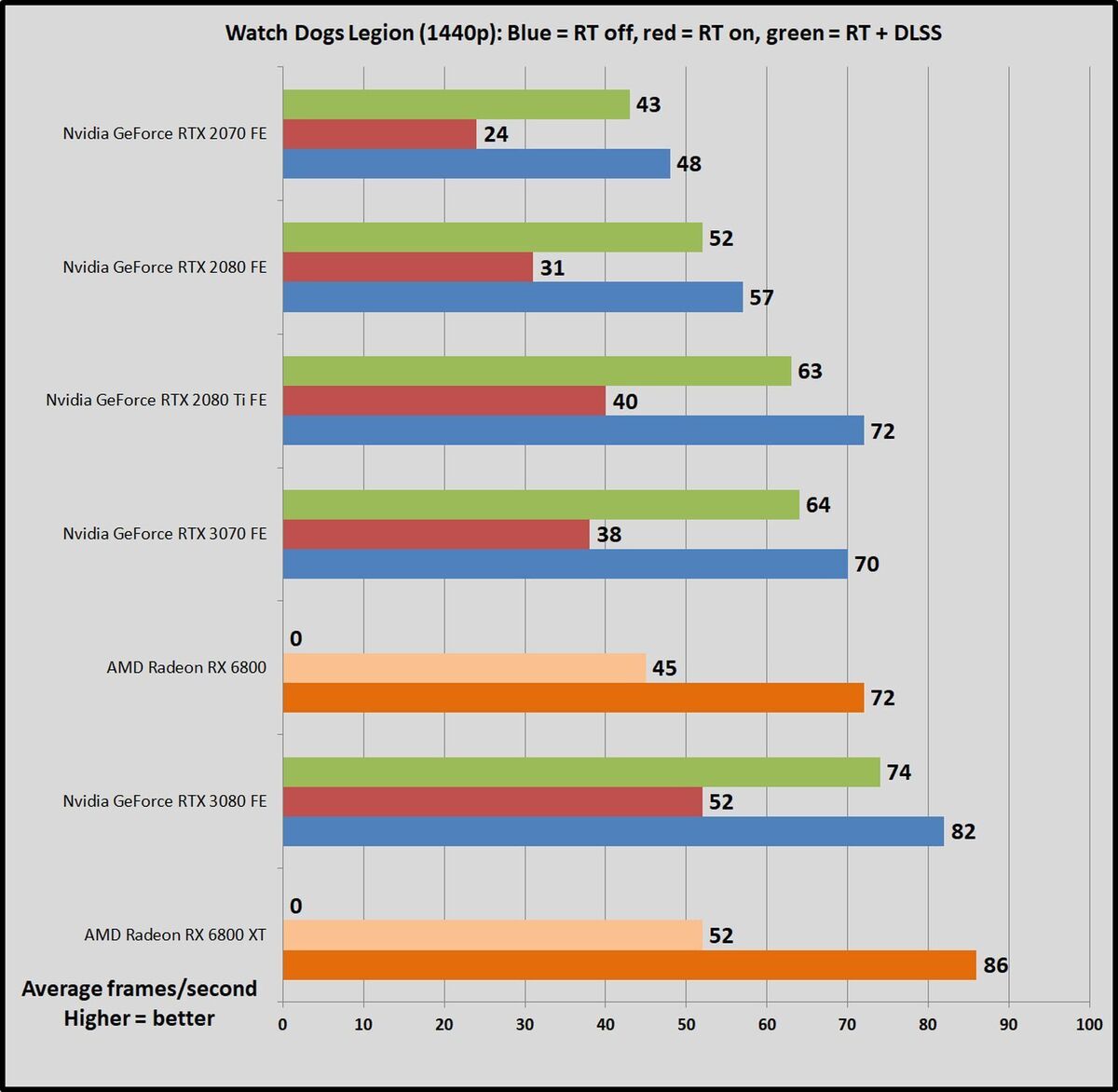 Brad Chacos/IDG
Brad Chacos/IDG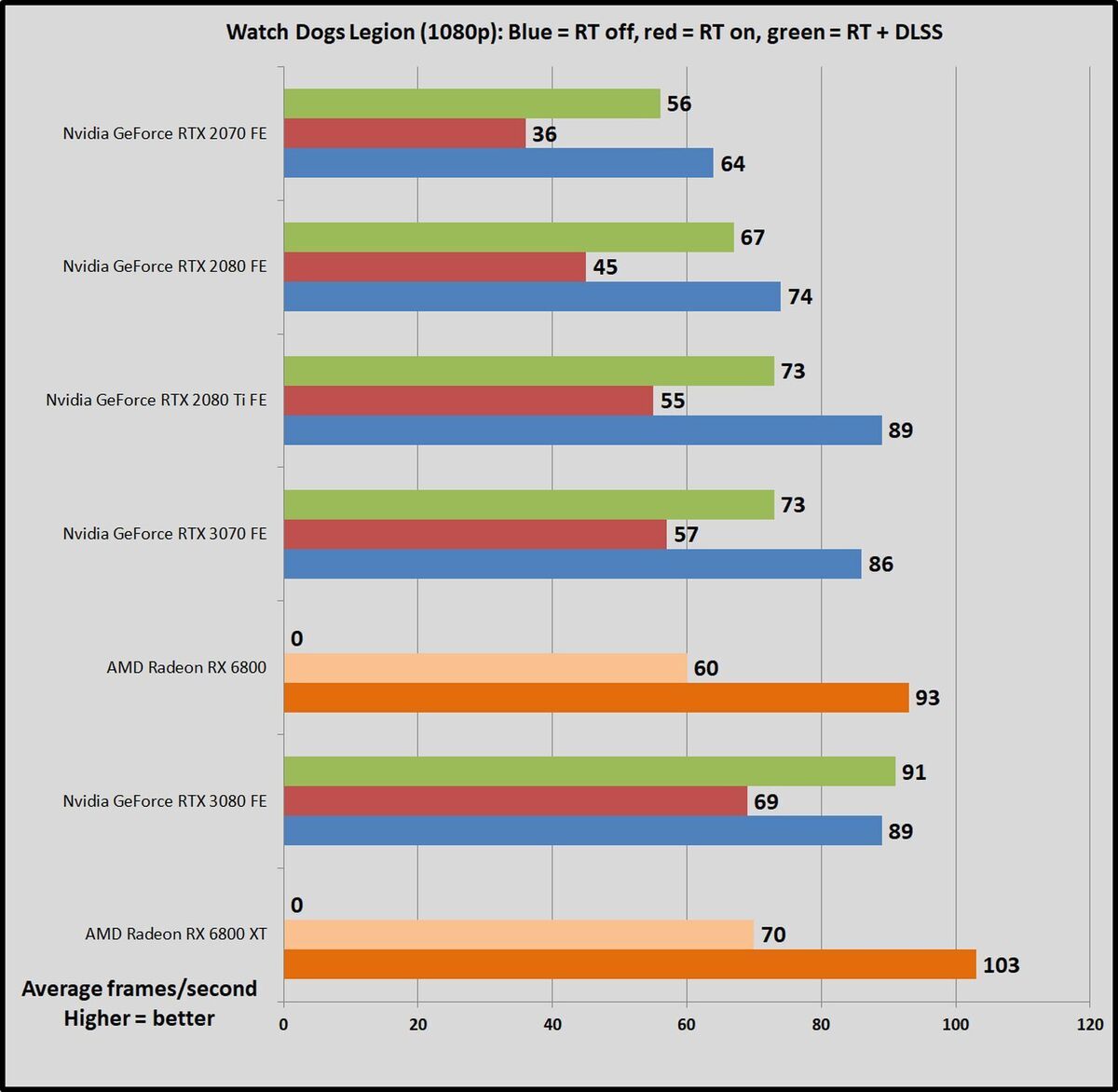 Brad Chacos/IDG
Brad Chacos/IDGThe Radeon RX 6800 XT is 40 percent slower with ray tracing on at 1440p resolution, while the Radeon RX 6800 is 38 percent slower. By contrast, the RTX 3080 is 37 percent slower, while the RTX 3070 is 45 percent slower. You also can see that the Radeon RX 6800 delivers better ray tracing performance than Nvidia’s last-gen cards by comparing this result against the RTX 2080 Ti.
Interestingly, the Radeon GPUs suffer a bit less of a performance penalty than they do in the other games, while the GeForce cards get hit a bit harder. This game uses large amounts of memory, surpassing the RTX 3070’s 8GB capacity even at 1440p with ray tracing off. Turning it on increases the demands further. The beefier 16GB of memory on AMD’s cards help give them an edge here, letting the Radeon RX 6800 XT match the RTX 3080’s performance with ray tracing on at 1440p, while the RX 6800 is 18 percent faster than the RTX 3070.
That lead disappears once you flip on DLSS, of course, but it’s an encouraging sign for AMD’s design decisions. The RTX 3080 cannot hit 60 fps at 4K resolution even with DLSS enabled, and the 3070 can’t achieve 40 fps. AMD’s cards once again deliver playable frame rates at 1440p and 1080p, though they can’t quite hit 60 fps with all the visual bells and whistles cranked at 1440p. That’s more acceptable in an open-world third-person game like Legion, but you should easily be able to get to 60 fps by tinkering with various visual options.
All in all, the Radeon RX 6800-series GPUs deliver solid ray tracing performance at the most commonly played resolutions, 1440p and 1080p. Nvidia’s second-gen implementation has a performance advantage, and DLSS extends it even further. Ray tracing hits memory hard, though, and the larger VRAM capacity in the Radeon GPUs might be an advantage for them in future titles, like it is in Watch Dogs currently.
Next page: Power, thermals, and noise
Power draw, thermals, and noise
We test power draw by looping the F1 2020 benchmark at 4K for about 20 minutes after we’ve benchmarked everything else and noting the highest reading on our Watts Up Pro meter, which measures the power consumption of our entire test system. The initial part of the race, where all competing cars are onscreen simultaneously, tends to be the most demanding portion.
This isn’t a worst-case test; we removed the Core i7 8700K’s overclock and specifically chose a GPU-bound game running at a GPU-bound resolution to gauge performance when the graphics card is sweating hard. If you’re playing a game that also hammers the CPU, you could see higher overall system power draws. Consider yourself warned.
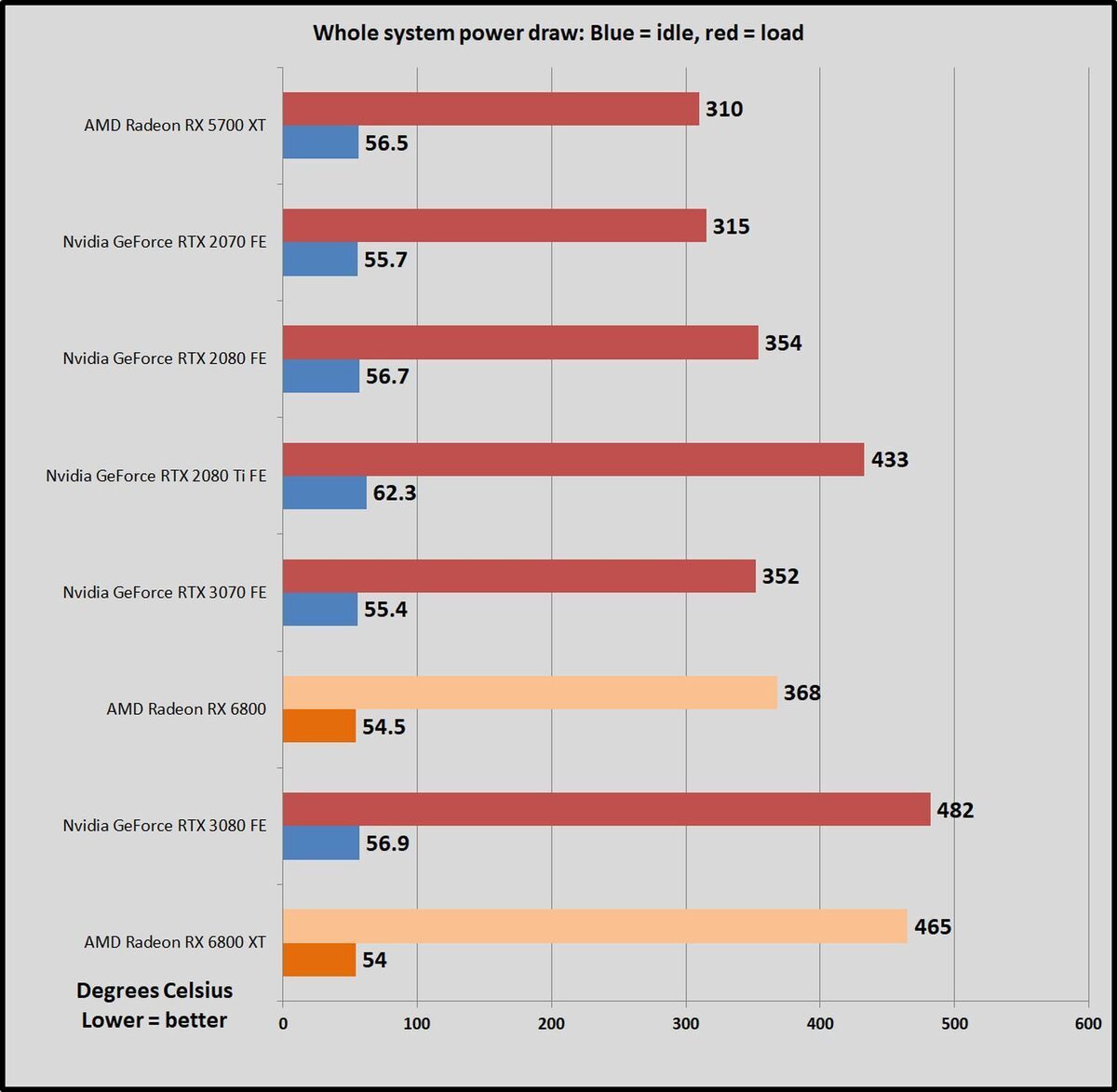 Brad Chacos/IDG
Brad Chacos/IDGYou can see the improved efficiency of the RDNA 2 architecture in the Radeon RX 6800 XT’s results. Despite trading blows with the RTX 3080 at 4K and often beating it outright at 1440p gaming, AMD’s card uses less power than its rival. The step-down Radeon RX 6800 is flat-out more powerful than the RTX 3070, so it’s no surprise to see it draw slightly more power than the GeForce card. That said, the RX 6800 barely uses more power than the RTX 3070 and also packs in twice as much RAM. It’s a good showing for AMD.
We test thermals by leaving GPU-Z open during the F1 2020 power draw test, noting the highest maximum temperature at the end.
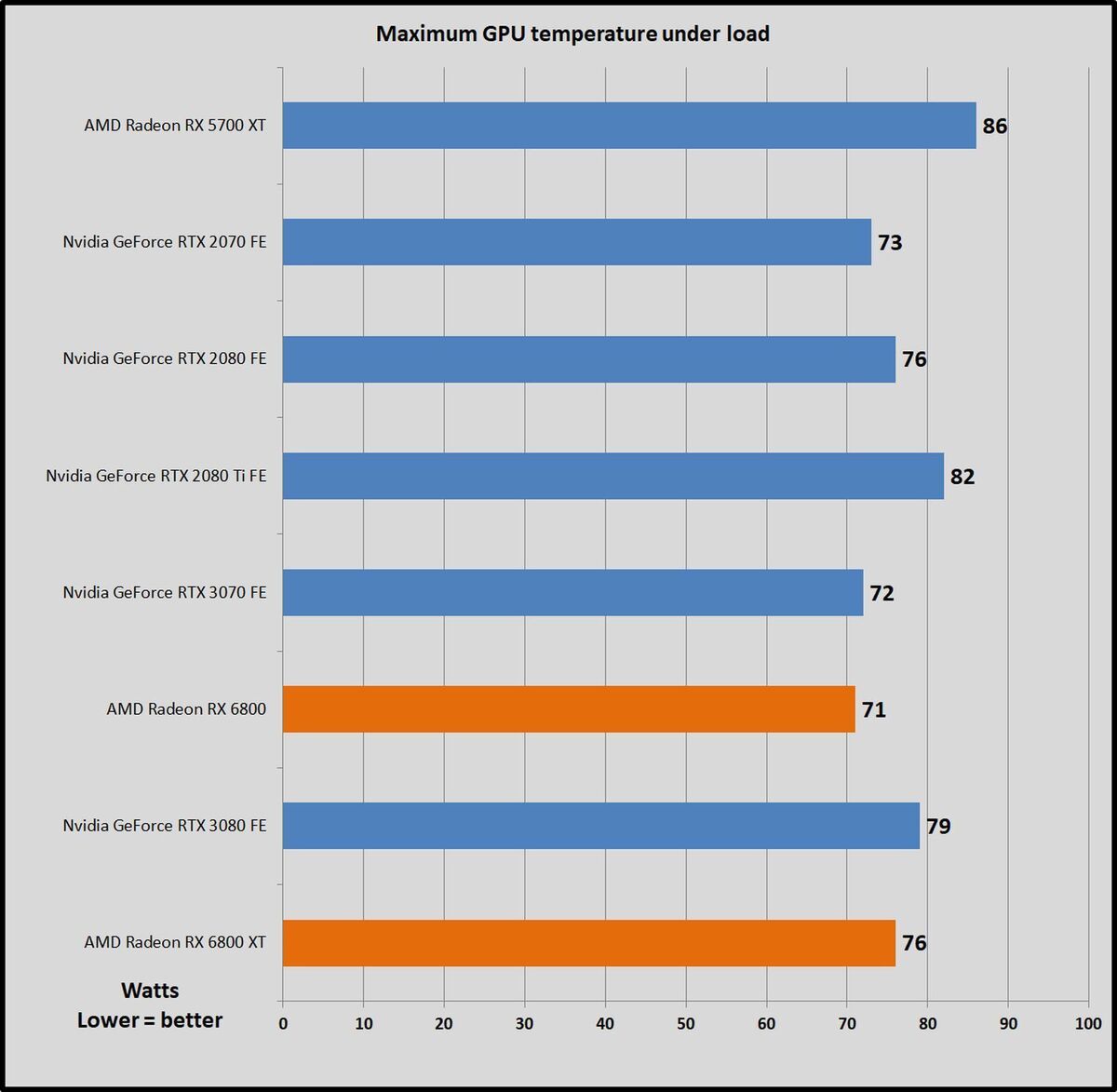 Brad Chacos/IDG
Brad Chacos/IDGAMD’s switch to axial cooling delivers solid results, and a tremendous improvement over previous Radeon reference boards. The ultra-powerful Radeon RX 6800 XT maxed out at 76 degrees Celsius in our system, a whopping 10 degrees below what the blower-style cooler on the last-gen Radeon RX 5700 XT hits—and that was a midrange GPU.
Nvidia’s radical “flow-through” cooling system with its whole-chassis heat sink helps the RTX 30-series Founders Edition cards run much more quietly than AMD’s Radeon RX 6800-series options. The Radeon RX 6800 and 6800 XT nevertheless achieve perfectly acceptable noise levels, unlike the blower coolers of old. You’ll hear these cards when you’re gaming, yes—there’s still room for AMD’s custom board partners to innovate here—but not anywhere near annoying levels. The Radeon RX 6800 XT is louder than the 6800 despite its extra half-slot of heatsink capacity, and our model exhibited faint coil whine when it hit especially high frame rates in Strange Brigade and Rainbow Six Siege. That can happen to any individual card, and we only noticed it only when the 6800 XT was pumping out several hundred frames per second.
Bottom line? These are good coolers, with nothing to complain about—something you couldn’t say about AMD reference boards in the past.
Next page: Should you buy the Radeon RX 6800 and 6800 XT?
Should you buy the Radeon RX 6800 or 6800 XT?
Definitely. The Radeon RX 6800-series is a stunning return to the high end for AMD, proving that yes, Team Red can still go blow-for-blow with Nvidia’s top offerings. These are outstanding graphics cards.
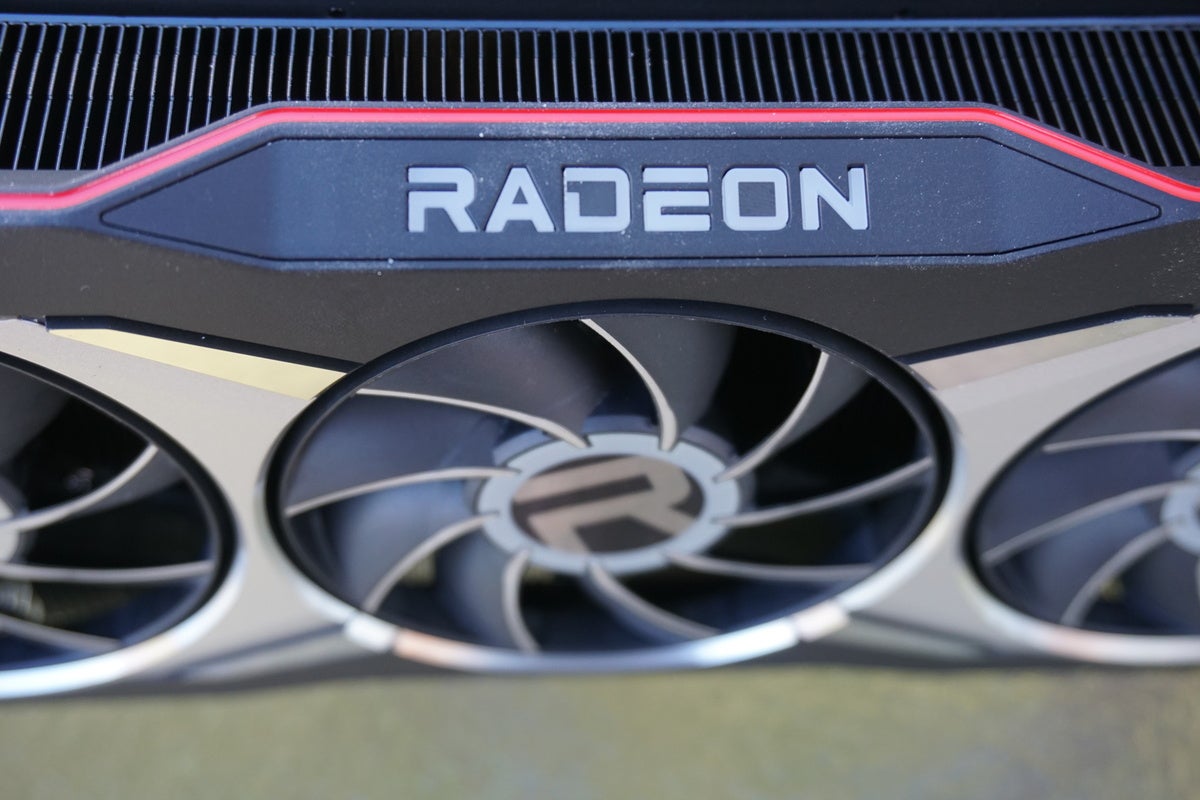 Brad Chacos/IDG
Brad Chacos/IDGThe $580 Radeon RX 6800 triumphs over the $500 GeForce RTX 3070 in most situations. The $650 Radeon RX 6800 XT trades blows with the pricier $700 GeForce RTX 3080 at 4K, but typically surges past its rival as you move down to 1440p and 1080p resolution. That’s the common performance theme. Nvidia loaded its Ampere architecture with abundant CUDA cores that deliver excellent 4K performance, but the RTX 30-series struggles to keep all those cores fed at lower resolutions. AMD’s RDNA 2-based graphics cards scale down much more gracefully. If you’re planning to buy any of these $500-plus graphics cards for use with a high-refresh-rate 1440p or 1080p monitor, AMD is the clear choice.
The Radeon RX 6800-series delivers at 4K, too. The Radeon RX 6800 beats the RTX 3070 by a solid amount in most games, while the Radeon RX 6800 XT and RTX 3080 wind up within 5 frames of each other in everything but Strange Brigade, where Nvidia’s card wins by 9 percent.
AMD holds a key memory advantage for high-resolution gaming, too. Both of these cards come equipped with 16GB of GDDR6 memory, bolstered by the on-die 128MB “Infinity Cache.” By contrast, the RTX 3070 has 8GB of GDDR6, and the RTX 3080 has 10GB of faster GDDR6X memory. Some of today’s games already consume more than 8GB at 4K resolution. Rare titles use more than 10GB.
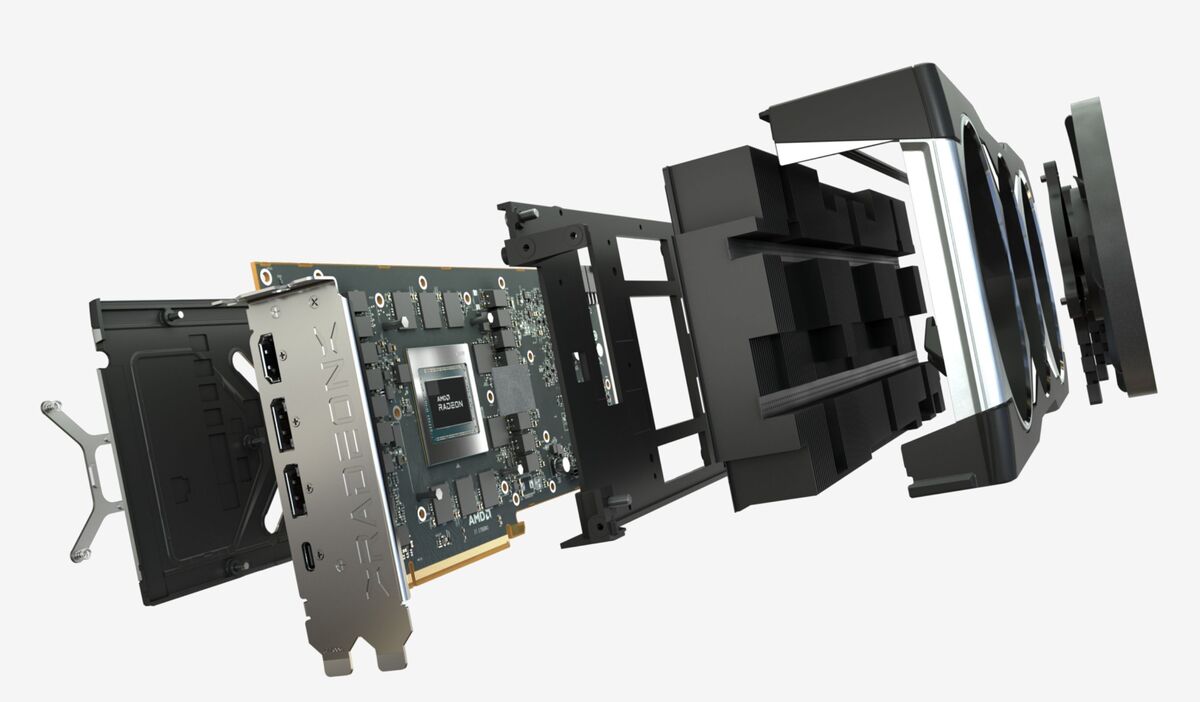 AMD
AMD
There’s an ample 16GB of GDDR6 memory built into the Radeon RX 6800-series GPUs, a key advantage.
Making matters worse for Nvidia, memory demands go up when you activate ray tracing, and new consoles just launched with larger memory pools than past generations. You won’t have to worry about AMD’s ample 16GB memory buffer running out of capacity for the foreseeable, but you might need to turn down texture settings on GeForce cards in a year or two.
Speaking of ray tracing, the cutting-edge lighting technology makes its debut in AMD’s RDNA 2 architecture. The technology is very intensive and creates a huge performance impact on any GPU. The Radeon RX 6800 and 6800 XT manage to achieve playable frame rates with ray tracing on at 1440p and 1080p resolution, especially if you don’t mind tweaking some settings, but not 4K. That’s a bummer. The GeForce RTX 30-series’ second-gen RT core implementation keeps performance higher than AMD’s ray accelerators, however, and AMD has no answer for Nvidia’s fantastic DLSS 2.0 technology that uses AI upsampling to claw back performance lost to all those bouncing rays. DLSS enables 4K gaming with ray tracing on. AMD has teased a more open DLSS rival dubbed “FidelityFX Super Resolution,” but it’s both mysterious and unavailable for now.
If great performance in ray-traced games is a goal for you—especially in games that use lot of ray-traced effects, like Minecraft RTX or Cyberpunk 2077—then Nvidia is the clear choice. That said, the 8GB memory buffer already slows down the RTX 3070 with ray tracing on in Watch Dogs: Legion. Decisions, decisions.
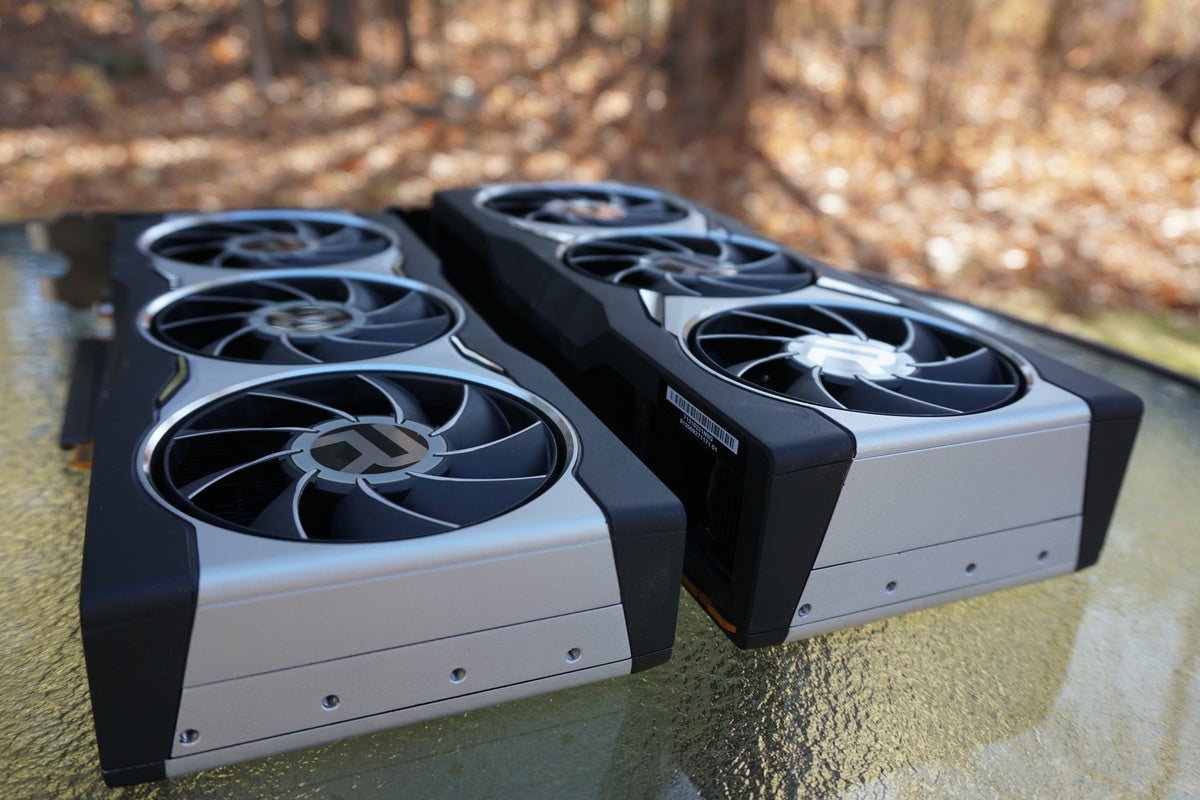 Brad Chacos/IDG
Brad Chacos/IDGAMD talks down about Nvidia’s ecosystem of proprietary features, but Green Team tools like G-Sync, DLSS, Nvidia Reflex, Nvidia Broadcast, Shadowplay, NVENC, and CUDA optimizations in creative workloads are all worthy reasons to forsake Team Red. AMD counters many of those with excellent features of its own—PR is keen to point out that pairing Radeon Boost with Radeon Anti-Lag challenges Nvidia Reflex, for example—but Nvidia invests a lot in its software ecosystem and has earned consumer trust over the years that AMD is still trying to win back. And again, the lack of a DLSS rival hurts, especially because some games that don’t support ray tracing are starting to include DLSS to boost performance.
AMD has a nifty trick up its own sleeve, though: Smart Access Memory. If you pair a Radeon RX 6000-series GPU with a Ryzen 5000 processor in an X570 motherboard, you’ll see performance increases of varying amounts in varying circumstances—in excess of 10 percent in the most favorable conditions, per AMD. It’s built using the PCIe spec’s Resizeable BAR attribute, so Intel and Nvidia may counter the technology with future BIOS updates, but for now, Smart Access Memory serves as the cornerstone of AMD’s Ryzen-and-Radeon “Ultimate Gaming Platform” pitch. We weren’t able to test it in time for this review, but stay tuned for an in-depth analysis soon.
Phew! Graphics cards sure are a lot more complicated than they used to be. Let’s bring it all together.
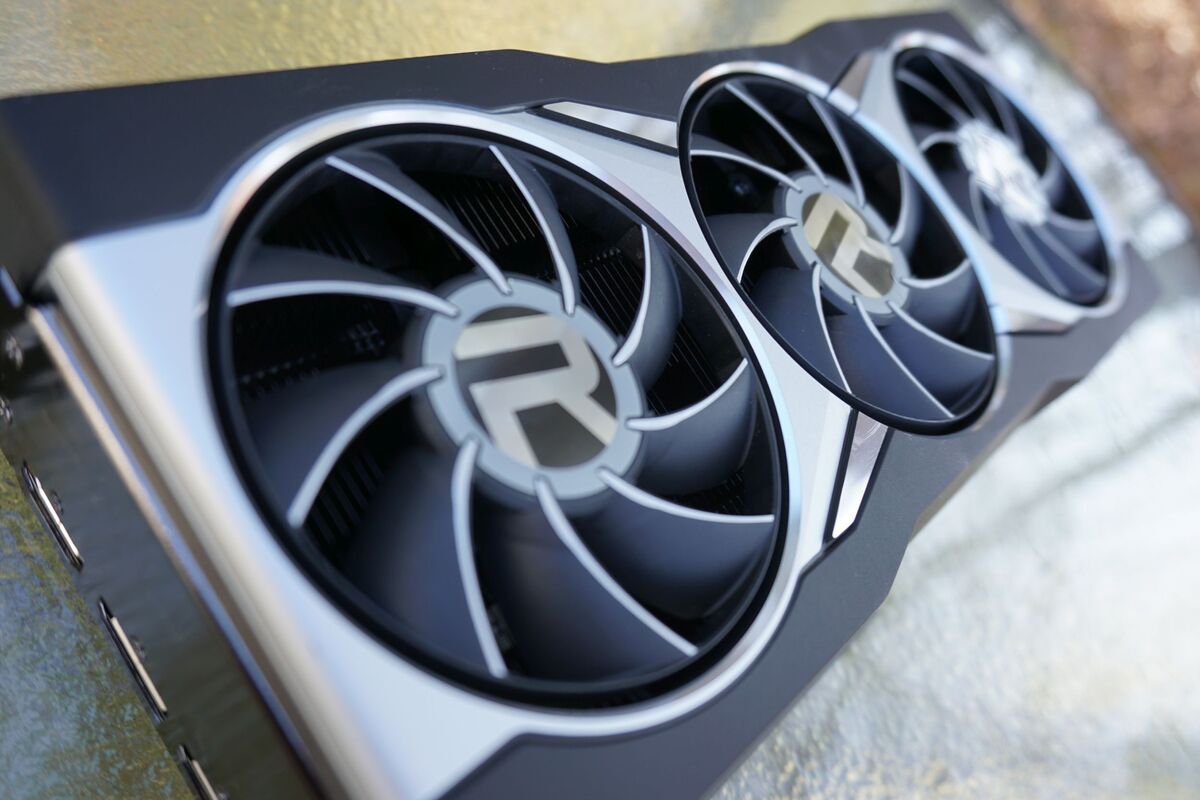 Brad Chacos/IDG
Brad Chacos/IDGThe $580 Radeon RX 6800 smokes the RTX 3070 in everything but ray tracing. It’s faster at 4K, it’s faster at high-refresh rate 1080p, and it packs twice as much memory, which feels significantly more future proof for the higher resolutions this card targets. If AMD priced the card closer to the RTX 3070’s $500 cost it would be a walk-off home run. As-is, the GeForce RTX 3070 is still worth considering for 1440p gaming given its substantially lower price tag, but I’d recommend spending up for the Radeon RX 6800—more for the increased VRAM than the raw performance. The 8GB capacity of the RTX 3070 is already limiting in some titles, and not just at 4K.
The $650 Radeon RX 6800 XT is also mighty enticing. Compared to the GeForce RTX 3080, it delivers comparable 4K performance, faster 1440p and 1080p performance, and 6GB more memory capacity, all for $50 less than Nvidia charges. Nvidia’s card uses faster GDDR6X memory, but raw capacity will probably make a bigger difference for 4K gaming in the years to come. The Radeon RX 6800 XT may be $650, but it delivers incredible value versus the competition.
Ray tracing performance, other Nvidia ecosystem features, and crucial DLSS support could sway you toward Team Green, especially if you’re already entrenched. The GeForce RTX 3070 and 3080 remain excellent cards that recently earned high marks in our reviews. But strongly consider joining the Red Team this time around. The Radeon RX 6800-series meets or beats the performance of its GeForce rivals in most circumstances and offer tangibly more memory capacity—a key metric at these lofty resolutions. I’m a massive believer in DLSS 2.0, but if I were spending my own money, I’d probably put my cash down on the Radeon GPUs, especially since I’m not a streamer or content creator who needs Nvidia’s excellent software ecosystem.
Welcome back to the high end, AMD. The Radeon RX 6800 and RX 6800 XT will melt your face. I can’t wait to see what the $999 Radeon RX 6900 XT can achieve when it launches December 8.





